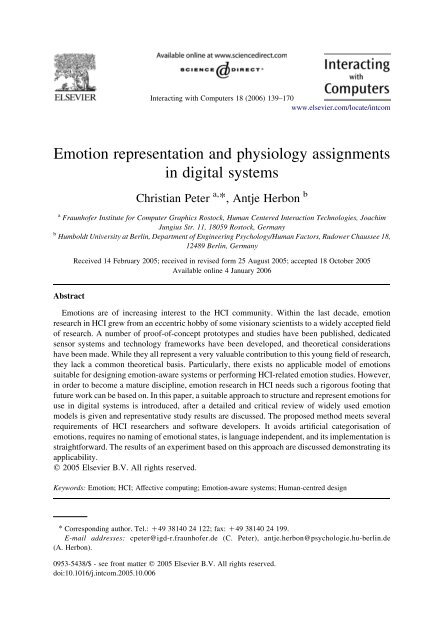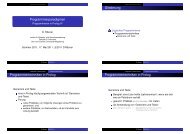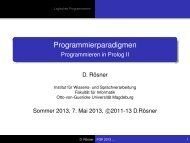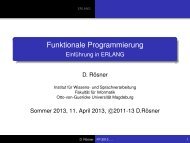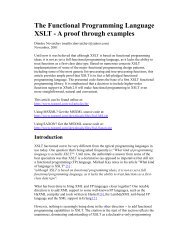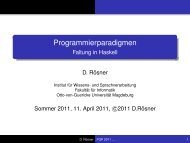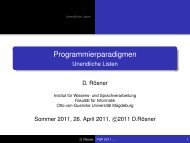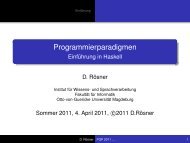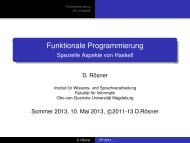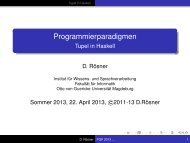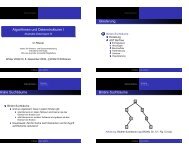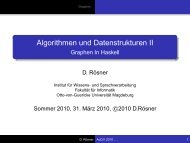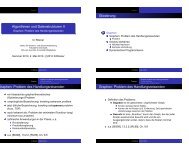Emotion representation and physiology assignments in digital systems
Emotion representation and physiology assignments in digital systems
Emotion representation and physiology assignments in digital systems
You also want an ePaper? Increase the reach of your titles
YUMPU automatically turns print PDFs into web optimized ePapers that Google loves.
Interact<strong>in</strong>g with Computers 18 (2006) 139–170<br />
www.elsevier.com/locate/<strong>in</strong>tcom<br />
<strong>Emotion</strong> <strong>representation</strong> <strong>and</strong> <strong>physiology</strong> <strong>assignments</strong><br />
<strong>in</strong> <strong>digital</strong> <strong>systems</strong><br />
Christian Peter a, *, Antje Herbon b<br />
a Fraunhofer Institute for Computer Graphics Rostock, Human Centered Interaction Technologies, Joachim<br />
Jungius Str. 11, 18059 Rostock, Germany<br />
b Humboldt University at Berl<strong>in</strong>, Department of Eng<strong>in</strong>eer<strong>in</strong>g Psychology/Human Factors, Rudower Chaussee 18,<br />
12489 Berl<strong>in</strong>, Germany<br />
Received 14 February 2005; received <strong>in</strong> revised form 25 August 2005; accepted 18 October 2005<br />
Available onl<strong>in</strong>e 4 January 2006<br />
Abstract<br />
<strong>Emotion</strong>s are of <strong>in</strong>creas<strong>in</strong>g <strong>in</strong>terest to the HCI community. With<strong>in</strong> the last decade, emotion<br />
research <strong>in</strong> HCI grew from an eccentric hobby of some visionary scientists to a widely accepted field<br />
of research. A number of proof-of-concept prototypes <strong>and</strong> studies have been published, dedicated<br />
sensor <strong>systems</strong> <strong>and</strong> technology frameworks have been developed, <strong>and</strong> theoretical considerations<br />
have been made. While they all represent a very valuable contribution to this young field of research,<br />
they lack a common theoretical basis. Particularly, there exists no applicable model of emotions<br />
suitable for design<strong>in</strong>g emotion-aware <strong>systems</strong> or perform<strong>in</strong>g HCI-related emotion studies. However,<br />
<strong>in</strong> order to become a mature discipl<strong>in</strong>e, emotion research <strong>in</strong> HCI needs such a rigorous foot<strong>in</strong>g that<br />
future work can be based on. In this paper, a suitable approach to structure <strong>and</strong> represent emotions for<br />
use <strong>in</strong> <strong>digital</strong> <strong>systems</strong> is <strong>in</strong>troduced, after a detailed <strong>and</strong> critical review of widely used emotion<br />
models is given <strong>and</strong> representative study results are discussed. The proposed method meets several<br />
requirements of HCI researchers <strong>and</strong> software developers. It avoids artificial categorisation of<br />
emotions, requires no nam<strong>in</strong>g of emotional states, is language <strong>in</strong>dependent, <strong>and</strong> its implementation is<br />
straightforward. The results of an experiment based on this approach are discussed demonstrat<strong>in</strong>g its<br />
applicability.<br />
q 2005 Elsevier B.V. All rights reserved.<br />
Keywords: <strong>Emotion</strong>; HCI; Affective comput<strong>in</strong>g; <strong>Emotion</strong>-aware <strong>systems</strong>; Human-centred design<br />
* Correspond<strong>in</strong>g author. Tel.: C49 38140 24 122; fax: C49 38140 24 199.<br />
E-mail addresses: cpeter@igd-r.fraunhofer.de (C. Peter), antje.herbon@psychologie.hu-berl<strong>in</strong>.de<br />
(A. Herbon).<br />
0953-5438/$ - see front matter q 2005 Elsevier B.V. All rights reserved.<br />
doi:10.1016/j.<strong>in</strong>tcom.2005.10.006
140<br />
C. Peter, A. Herbon / Interact<strong>in</strong>g with Computers 18 (2006) 139–170<br />
1. Introduction<br />
The HCI community is becom<strong>in</strong>g more <strong>and</strong> more aware of the importance of emotions<br />
<strong>in</strong> human–computer <strong>in</strong>teraction. Especially <strong>in</strong> the usability doma<strong>in</strong> there is a grow<strong>in</strong>g need<br />
<strong>and</strong> <strong>in</strong>terest <strong>in</strong> consider<strong>in</strong>g the emotional ‘property’ of users (Reeves <strong>and</strong> Nass, 1996;<br />
Picard, 1997; Marcus, 2003; Cockton, 2004). Traditional analysis concepts like mental<br />
models (Carroll <strong>and</strong> Olson, 1988) or users’ models (Sasse, 1997) help to underst<strong>and</strong> users’<br />
approaches to problem solv<strong>in</strong>g <strong>and</strong> <strong>in</strong>teraction with mach<strong>in</strong>es. <strong>Emotion</strong>s, however, are<br />
barely covered by those theories. Also, product designers started to explore emotional<br />
aspects <strong>in</strong> their doma<strong>in</strong>. Beg<strong>in</strong>n<strong>in</strong>g with Pat Jordan’s <strong>and</strong> Don Norman’s considerations<br />
(Jordan, 2002; Norman, 2004), more <strong>and</strong> more contributions have been made to this field,<br />
like Pieter Desmet’s work (Desmet, 2002). In the field of human–computer <strong>in</strong>teraction,<br />
Rosal<strong>in</strong>d Picard’s work on affective comput<strong>in</strong>g has enormously <strong>in</strong>creased the momentum<br />
of HCI-related emotion research (Picard, 1997; 1999). Today, there are several<br />
publications available on proof-of-possibility studies for emotion detection <strong>and</strong> affective<br />
response, for <strong>in</strong>stance André et al. (2000); Kort et al. (2001); Kle<strong>in</strong> et al. (2002); Picard<br />
<strong>and</strong> Kle<strong>in</strong> (2002); Scheirer et al. (2002), <strong>and</strong> Arafa et al. (2004). Dedicated sensor <strong>systems</strong><br />
<strong>and</strong> technology frameworks have been developed (Haag et al., 2004; Mader et al., 2004;<br />
Anttonen <strong>and</strong> Surakka, 2005; Peter et al., 2005), theoretical aspects have been addressed<br />
(Cañamero, 1999; Picard, 1999; Cockton, 2002; 2004; Hudlicka, 2003), <strong>and</strong> there are the<br />
first signs of a develop<strong>in</strong>g community <strong>in</strong>terested <strong>in</strong> emotions <strong>and</strong> their role <strong>in</strong> HCI (see<br />
Marcus, 2003; HUMAINE, 2005; ACII, 2005; Peter <strong>and</strong> Blyth, 2005).<br />
However, all activities so far have been restricted to be<strong>in</strong>g just possibility studies <strong>and</strong><br />
proof-of-concept prototypes without a clear theoretical foundation of emotions <strong>and</strong> how<br />
they should be dealt with by a <strong>digital</strong> system. Particularly, there exists no straightforward<br />
<strong>and</strong> applicable concept of structur<strong>in</strong>g emotions, which is a prerequisite for reliably<br />
obta<strong>in</strong><strong>in</strong>g, stor<strong>in</strong>g, <strong>and</strong> f<strong>in</strong>ally process<strong>in</strong>g emotion data. While there is a huge variety of<br />
emotion models <strong>in</strong> psychology, emotion related HCI research has so far widely neglected<br />
the need of an underly<strong>in</strong>g theoretical model of emotions (cf. Cockton, 2004; Muller,<br />
2004). Recently, some researchers have realised the need for an underly<strong>in</strong>g theory for<br />
properly correlat<strong>in</strong>g physiological data 1 with emotional states. Several models of emotions<br />
developed by psychologists have been tried, like OCC (Ortony et al., 1988), or those from<br />
Scherer (1984); Frijda (1986), <strong>and</strong> Roseman et al. (1996). However, it is difficult to take a<br />
theory of one research field, like psychology or cognitive neuroscience, <strong>and</strong> apply it to<br />
another, like HCI. The same problem has been experienced by the HCI community <strong>in</strong> the<br />
late 1980s <strong>and</strong> 1990s, when cognitive processes were to be <strong>in</strong>cluded <strong>in</strong> HCI research (cf.<br />
Rogers, 2004). Why should it be different with emotions? The emotion models developed<br />
by psychologists have been designed to study emotions <strong>in</strong> general. They do not just<br />
conta<strong>in</strong> correlations between physiological <strong>and</strong> emotional states, but also different ideas<br />
on the cause of the aris<strong>in</strong>g emotion, underly<strong>in</strong>g biological processes, anatomical<br />
structures, <strong>and</strong> other psychological considerations (cf. Davidson, 2003). Furthermore,<br />
1 The term ‘physiological data’ here refers to any observable physiological changes, such as heart rate, sk<strong>in</strong><br />
resistance, sk<strong>in</strong> temperature, mimics, gestures, posture, voice characteristics, <strong>and</strong> others.
C. Peter, A. Herbon / Interact<strong>in</strong>g with Computers 18 (2006) 139–170 141<br />
discussions regard<strong>in</strong>g which model is eventually best suitable for measur<strong>in</strong>g emotions are<br />
very controversial, not least because some authors even question the fundamentals of these<br />
models (cf. Fredrickson, 1998; Sab<strong>in</strong>i <strong>and</strong> Silver, 2005).<br />
Implement<strong>in</strong>g these models <strong>in</strong> software hence proved to be very difficult, <strong>and</strong> s<strong>in</strong>ce the<br />
system developers were not psychologists, the result<strong>in</strong>g designs f<strong>in</strong>ally became simplified<br />
implementations of the orig<strong>in</strong>al models <strong>and</strong> were adapted to the very specific tasks <strong>in</strong><br />
m<strong>in</strong>d. Obviously, there is not a straightforward way from psychology to HCI. Rather,<br />
designers <strong>and</strong> researchers <strong>in</strong> HCI should selectively use relevant <strong>and</strong> applicable<br />
knowledge ga<strong>in</strong>ed by psychologists, tak<strong>in</strong>g the freedom to ignore aspects not relevant<br />
to their doma<strong>in</strong>. HCI researchers are <strong>in</strong>terested <strong>in</strong> other aspects of emotion than<br />
psychologists are, ma<strong>in</strong>ly <strong>in</strong> observable physiological manifestations of emotions<br />
occurr<strong>in</strong>g <strong>in</strong> real-life scenarios. Psychological emotion models do not live up to their<br />
requirements of applicability, comparability, <strong>and</strong> ease of use, as po<strong>in</strong>ted out later <strong>in</strong> this<br />
paper. What is needed for HCI researchers <strong>and</strong> practitioners are adequate measures to<br />
associate physiological measurements to unambiguous emotional states <strong>in</strong> order to f<strong>in</strong>ally<br />
assign them to conditions mean<strong>in</strong>gful to a computer (cf. Cockton, 2004; Bamidis et al.,<br />
2004; Wilson <strong>and</strong> Sasse, 2004; Ward <strong>and</strong> Marsden, 2004).<br />
The method described <strong>in</strong> this paper fulfils several requirements of HCI researchers <strong>and</strong><br />
software developers on such a basis. It avoids artificial categorisation of emotions, requires<br />
no nam<strong>in</strong>g of emotional states, is language <strong>in</strong>dependent, <strong>and</strong> straightforward to implement.<br />
In the follow<strong>in</strong>g section, an <strong>in</strong>troductory overview of the two ma<strong>in</strong> models used to<br />
structure emotions is given <strong>and</strong> the support<strong>in</strong>g physiological f<strong>in</strong>d<strong>in</strong>gs are presented for<br />
each, from different studies. This is followed by a discussion of the disadvantages,<br />
shortcom<strong>in</strong>gs, <strong>and</strong> pitfalls of the discussed emotion models, from an HCI perspective.<br />
Based on this analysis, a new approach to structure emotion has been developed with a<br />
focus on its applicability <strong>in</strong> HCI research <strong>and</strong> application design. Results of an experiment<br />
based on this approach are described which show the applicability of the new approach.<br />
2. Two ma<strong>in</strong> approaches to structure emotion<br />
Current theories from psychology on emotions can be grouped <strong>in</strong>to theories that focus<br />
on how emotions arise <strong>and</strong> how they are perceived, <strong>and</strong> theories focuss<strong>in</strong>g on how<br />
observed emotions could be categorised or structured. S<strong>in</strong>ce theoretical aspects on how<br />
emotions arise, when <strong>and</strong> how they are perceived, <strong>and</strong> which biological mechanisms<br />
<strong>in</strong>duce them are less important for <strong>systems</strong> to recognise emotions, these approaches would<br />
not be reviewed <strong>in</strong> this paper. Please refer to the respective literature (e.g. Scherer, 1984;<br />
Frijda, 1986; Roseman et al., 1996).<br />
Among the theories for categoris<strong>in</strong>g or structur<strong>in</strong>g emotions, two ma<strong>in</strong> theories are<br />
currently established: a discrete approach, claim<strong>in</strong>g the existence of universal ‘basic<br />
emotions’ (e.g. Plutchik, 1980; Ekman, 1992), <strong>and</strong> a dimensional approach, assum<strong>in</strong>g the<br />
existence of two or more major dimensions which are able to describe different emotions<br />
<strong>and</strong> to dist<strong>in</strong>guish between them (e.g. Russell, 1980). There is still controversy on the<br />
matter of which approach is the one that best captures the structure of emotion even though<br />
attempts have been made to conflate the two (Russell <strong>and</strong> Feldman Barrett, 1999).
142<br />
C. Peter, A. Herbon / Interact<strong>in</strong>g with Computers 18 (2006) 139–170<br />
2.1. Discrete emotion theories <strong>and</strong> the concept of basic emotions<br />
Discrete emotion theories claim the existence of historically evolved basic emotions,<br />
which are universal <strong>and</strong> can therefore be found <strong>in</strong> all cultures. Several psychologists have<br />
suggested a different number of these, rang<strong>in</strong>g from 2 to 18 categories, but there has been<br />
considerable agreement on the follow<strong>in</strong>g six: anger, disgust, fear, happ<strong>in</strong>ess, sadness <strong>and</strong><br />
surprise. Several arguments for the existence of these categories have been provided, like<br />
dist<strong>in</strong>ct universal facial signals, dist<strong>in</strong>ct universals <strong>in</strong> antecedent events, presence <strong>in</strong> other<br />
primates etc. Ekman (<strong>and</strong> also other researchers) based his assumptions ma<strong>in</strong>ly on the<br />
facial expression of emotions. In his studies, facial expressions of emotions were<br />
recognised by people from very different cultures.<br />
Russell (1994), however, found that there are differences <strong>in</strong> the recognition ability for<br />
subjects of different orig<strong>in</strong>s. While western literate groups widely agree about emotions<br />
presented by photographs, people from isolated groups often do not agree with them. These<br />
differences challenge the universality view. Carroll <strong>and</strong> Russell (1996) conducted an<br />
experiment focuss<strong>in</strong>g on emotion recognition from pictures <strong>in</strong> a semantic context <strong>and</strong> found<br />
first, that they could not replicate the high recognition rates for the POFA (Pictures of Facial<br />
Affect; Ekman <strong>and</strong> Friesen, 1976) that had been reported <strong>and</strong> second, that there exists<br />
situational dom<strong>in</strong>ance when pictures are presented <strong>in</strong> an emotionally different context.<br />
2.1.1. Empirical evidence<br />
Over the last decades, many experiments have been performed <strong>in</strong> search of universal<br />
physiological patterns specific to basic emotions. Those studies concentrated ma<strong>in</strong>ly on<br />
activities of the autonomous nervous system (ANS) <strong>and</strong> characteristic speech signal<br />
changes. ANS related studies (e.g. Ax, 1953; Ekman et al., 1983; Palomba et al., 1993,<br />
1999; Prkach<strong>in</strong> et al., 1999; <strong>and</strong> many others) showed very <strong>in</strong>terest<strong>in</strong>g results each on its<br />
own, but until now no dist<strong>in</strong>ct patterns for the six basic emotions mentioned above could<br />
be found that all agree on. The results of the studies are controversial <strong>and</strong> the variables<br />
measured do not seem to allow dist<strong>in</strong>guish<strong>in</strong>g clearly between different emotions. Some<br />
stable results could be found for variables that seem to characterise certa<strong>in</strong> basic emotions,<br />
especially fear <strong>and</strong> anger, which are the two that previous studies have focussed on mostly.<br />
Appendix A summarizes 13 of these ANS-studies that resulted <strong>in</strong> the follow<strong>in</strong>g<br />
commonalities. For fear: <strong>in</strong>crease of heart rate, sk<strong>in</strong> conductance level <strong>and</strong> systolic blood<br />
pressure; for anger: <strong>in</strong>crease of heart rate, systolic <strong>and</strong> diastolic blood pressure. Measur<strong>in</strong>g<br />
sadness seems to be more difficult, which results <strong>in</strong> the circumstance that only eight out of<br />
the 13 studies assessed that emotion. Because of this, the results are not as clear as for fear<br />
<strong>and</strong> anger. Christie (2002); Fredrickson et al. (2000) found a decrease <strong>in</strong> heart rate, while<br />
Levenson et al. (1990); Neumann <strong>and</strong> Waldste<strong>in</strong> (2001); Prkach<strong>in</strong> et al. (1999); Schwartz<br />
et al. (1981) reported an <strong>in</strong>crease of heart rate, while Palomba <strong>and</strong> Stegagno (1993) could<br />
not f<strong>in</strong>d any significant difference to the measured basel<strong>in</strong>e. Disgust seems to represent an<br />
even greater problem. It was only assessed by four out of the 13 studies. The results are not<br />
very promis<strong>in</strong>g. Also, measur<strong>in</strong>g positive emotions such as happ<strong>in</strong>ess seems to be very<br />
troublesome as can be observed especially <strong>in</strong> diastolic <strong>and</strong> systolic blood pressure <strong>and</strong><br />
heart rate data, which ranged from decreases to even strong <strong>in</strong>creases <strong>in</strong> the seven reported
C. Peter, A. Herbon / Interact<strong>in</strong>g with Computers 18 (2006) 139–170 143<br />
studies. Amusement <strong>and</strong> surprise were only assessed <strong>in</strong> one study each by Christie (2002)<br />
<strong>and</strong> Ekman et al. (1983) accord<strong>in</strong>gly.<br />
Speech analysis has also been performed with the same goal to f<strong>in</strong>d specific patterns <strong>in</strong> the<br />
speech signal that will confirm the existence of basic emotion categories (for a summary see<br />
Scherer (2003)). The results were less controversial than those of the ANS-studies, especially<br />
when the level of arousal/<strong>in</strong>tensity was taken <strong>in</strong>to account, i.e. when anger was divided <strong>in</strong>to<br />
hot <strong>and</strong> cold anger with high <strong>and</strong> low arousal, respectively (e.g. Banse <strong>and</strong> Scherer, 1996).<br />
Panic correlated significantly with an <strong>in</strong>crease <strong>in</strong> <strong>in</strong>tensity of the voice, <strong>in</strong>crease of F 0 floor/<br />
mean 2 <strong>and</strong> <strong>in</strong>crease of the speech/articulation rate, while for anxiety the F 0 floor/mean <strong>and</strong><br />
voice <strong>in</strong>tensity decreased. For hot <strong>and</strong> cold anger there were no differences concern<strong>in</strong>g the<br />
direction of change from basel<strong>in</strong>e for <strong>in</strong>tensity, nor for F 0 floor/mean or hot anger. The<br />
parameters all <strong>in</strong>creased, even though the <strong>in</strong>crease <strong>in</strong> <strong>in</strong>tensity was respectively, higher for hot<br />
anger than for cold anger. For the analyses of sadness, Banse <strong>and</strong> Scherer (1996) <strong>and</strong><br />
Burkhardt <strong>and</strong> Sendlmeier (2000) divided the emotion <strong>in</strong>to quiet sorrow for low arousal level<br />
<strong>and</strong> cry<strong>in</strong>g despair for high arousal level. While Intensity <strong>and</strong> F 0 floor/mean <strong>in</strong>creased for<br />
cry<strong>in</strong>g despair, it decreased for quiet sorrow. The speech/articulation rate decreased for both<br />
forms of sadness, but the decrease was greater for quiet sorrow. Most studies <strong>in</strong> the past have<br />
<strong>in</strong>vestigated the low arousal form, which is why they agree on decreases <strong>in</strong> the mentioned<br />
parameters for sadness (Johnstone <strong>and</strong> Scherer, 2000; Murray <strong>and</strong> Arnott, 1993;<strong>and</strong>Scherer,<br />
1993). The positive emotion of happ<strong>in</strong>ess has also been <strong>in</strong>vestigated. Here also, two arousal<br />
states were identified. Happ<strong>in</strong>ess is a low arousal form whereas joy is considered be<strong>in</strong>g the<br />
high arousal version. Intensity, F 0 floor/mean <strong>and</strong> speech rate have all shown to <strong>in</strong>crease for<br />
joy, but decrease for happ<strong>in</strong>ess. Nonetheless, until today no unambiguous dist<strong>in</strong>ctive patterns<br />
could be doubtlessly confirmed, especially because arousal levels are often neglected (see<br />
Appendix B for a summary).<br />
Exam<strong>in</strong>ations of the semantics of basic emotion terms by Wierzbicka (1992) showed<br />
contradictive results. She expla<strong>in</strong>ed that for some languages certa<strong>in</strong> words describ<strong>in</strong>g<br />
basic emotions do not exist (such as the word anger for the Ilongot language of the<br />
Philipp<strong>in</strong>es or the Ifaluk language of Micronesia) <strong>and</strong> concluded that the basic emotions<br />
are just cultural artefacts of the English language.<br />
2.2. Dimensional emotion theories <strong>and</strong> the Circumplex model of affect<br />
Dimensional emotion theories use dimensions rather than discrete categories to<br />
describe the structure of emotions. Accord<strong>in</strong>g to a dimensional view, all emotions are<br />
characterised by their valence <strong>and</strong> arousal 3 . Some models have suggested an even greater<br />
number of dimensions, but the additional dimensions (e.g. control) could usually not add<br />
much to the overall variance that could be accounted for.<br />
However, arousal <strong>and</strong> valence are not claimed to be the only dimensions or to be<br />
sufficient to differentiate equally between all emotions, but they have proved to be the two<br />
2 F 0 is the fundamental frequency of a voice signal, see Appendix B for a def<strong>in</strong>ition.<br />
3 While we use the terms valence <strong>and</strong> arousal here, the exact titl<strong>in</strong>g of the two dimensions has been very<br />
controversial, see Feldman Barrett <strong>and</strong> Russell (1998) for a discussion on the topic <strong>and</strong> Russell <strong>and</strong> Feldman<br />
Barrett (1999) for a review of other dimensional theories.
144<br />
C. Peter, A. Herbon / Interact<strong>in</strong>g with Computers 18 (2006) 139–170<br />
Fig. 1. A Circumplex model of affect (taken from Russell, 1980).<br />
ma<strong>in</strong> dimensions (Russell, 1983). Cowie et al. (1999) suggested additional features that are<br />
not part of every emotion, but of certa<strong>in</strong> ones. They found that some emotions that share the<br />
same degrees of arousal <strong>and</strong> valence but are perfectly dist<strong>in</strong>guishable <strong>in</strong> everyday life (e.g.<br />
fear <strong>and</strong> anger) could be better discrim<strong>in</strong>ated by compar<strong>in</strong>g these additional features.<br />
When Russell started conduct<strong>in</strong>g self-report studies on the structure of emotion with the<br />
two-dimensional approach, he discovered a specific order<strong>in</strong>g of the words describ<strong>in</strong>g the<br />
felt emotions. The rat<strong>in</strong>gs did not fall <strong>in</strong> every area of the coord<strong>in</strong>ate system, but <strong>in</strong>stead<br />
clustered around the periphery of a circle. He called the result<strong>in</strong>g configuration the<br />
Circumplex of affect (see Fig. 1). This structure has been replicated many times <strong>in</strong> English<br />
<strong>and</strong> many other languages (e.g. Russell, 1983; Russell et al., 1989; Västfjäll, 2000) <strong>and</strong> it<br />
has been challenged, e.g. by Bradley et al. (1993).<br />
2.2.1. Empirical evidence<br />
Bradley et al. (1993) correlated the arousal <strong>and</strong> valence dimensions with sk<strong>in</strong><br />
conductance level (SCL), zygomatic 4 <strong>and</strong> corrugator 5 electromyogram (ZEMG, CEMG)<br />
<strong>and</strong> heart rate. They found a positive correlation between SCL <strong>and</strong> arousal <strong>and</strong> between<br />
4 Corners of the mouth.<br />
5 Eyebrows.
C. Peter, A. Herbon / Interact<strong>in</strong>g with Computers 18 (2006) 139–170 145<br />
heart rate <strong>and</strong> the valence of an emotion, <strong>and</strong> a negative correlation for CEMG <strong>and</strong> valence.<br />
ZEMG was found to be slightly <strong>in</strong>creased for low valence, slightly decreased for a neutral<br />
state <strong>and</strong> strongly <strong>in</strong>creased for high valence (see Appendix C). Branco et al. (2005)<br />
conducted an HCI experiment with tasks of vary<strong>in</strong>g difficulty. Us<strong>in</strong>g unsolvable tasks, they<br />
<strong>in</strong>duced irritation <strong>in</strong> users <strong>and</strong> could observe <strong>in</strong>creases <strong>in</strong> EMG signals for this negative<br />
affective state. Bradley et al.’s results for heart rate were not as clear as the EMG patterns,<br />
with the correlations be<strong>in</strong>g much smaller. Neumann <strong>and</strong> Waldste<strong>in</strong> (2001) <strong>and</strong> Ritz<br />
<strong>and</strong> Thöns (2002) could not f<strong>in</strong>d any heart rate differences at all between positive <strong>and</strong><br />
negative emotions. Detenber et al. (1998) found a positive correlation between arousal <strong>and</strong><br />
SCL too, but could not quite replicate Bradley’s f<strong>in</strong>d<strong>in</strong>gs on correlations between heart rate<br />
<strong>and</strong> valence. They did f<strong>in</strong>d a deceleration for negative valence stimuli, but they found the<br />
same for positive stimuli, although not as strong. In addition, heart rate deceleration<br />
correlated with high <strong>and</strong> low arousal <strong>in</strong> as far as it was stronger than for medium arousal.<br />
Anttonen <strong>and</strong> Surakka (2005) found similar results while measur<strong>in</strong>g heart rate with the<br />
EMFi chair (an office chair that allows unobtrusive heart rate measurement). They presented<br />
positive, negative <strong>and</strong> neutral stimuli to 26 subjects <strong>and</strong> found a stronger deceleration of<br />
heart rate for negative than for positive or neutral stimulation. Interest<strong>in</strong>gly, when<br />
compar<strong>in</strong>g <strong>in</strong>dividual response patterns to the mean response pattern over all subjects for<br />
each of the stimulus groups (positive, negative, neutral), they found that only 62.5% of the<br />
<strong>in</strong>dividual curves were adequately <strong>in</strong> l<strong>in</strong>e with the mean curve, <strong>in</strong>dicat<strong>in</strong>g strong <strong>in</strong>ter<strong>in</strong>dividual<br />
differences. In 16.7% of the cases, the authors could not show different responses<br />
for positive <strong>and</strong> negative stimuli at all. These f<strong>in</strong>d<strong>in</strong>gs suggest that physiological responses<br />
cannot be generalised for all people but differ considerably from <strong>in</strong>dividual to <strong>in</strong>dividual.<br />
However, care has to be taken with some of Anttonnen <strong>and</strong> Surakka’s results due to<br />
methodological issues. The rat<strong>in</strong>gs of all subjects have been grouped by their mean rat<strong>in</strong>gs<br />
<strong>and</strong> have not been analysed for their <strong>in</strong>dividual differences. In addition, the results have not<br />
been controlled for their level of arousal, i.e. stimuli for negative valence also had an<br />
arous<strong>in</strong>g effect, which has not been considered <strong>in</strong> the evaluation of the physiological data.<br />
Pereira (2000) <strong>and</strong> Schröder et al. (2001) correlated voice quality parameters, such as<br />
frequency <strong>and</strong> <strong>in</strong>tensity, with valence <strong>and</strong> arousal <strong>and</strong> received promis<strong>in</strong>g results (see<br />
Appendix D). Voice correlates seem to be more clear <strong>and</strong> less controversial than EMG, SCL<br />
<strong>and</strong> heart rate results, but are ma<strong>in</strong>ly found for arousal. Küstner et al. (2004) found that <strong>in</strong><br />
speech more prosody features correlate with arousal than quality features, but that also some<br />
prosody features rank high <strong>in</strong> valence <strong>and</strong> quality features correlate also with arousal. For<br />
<strong>in</strong>stance, for prosody features, energy variance, mean square error of l<strong>in</strong>ear regression of F 0 ,<br />
<strong>and</strong> the length of the longest unvoiced region show high correlation with arousal, while F 0 at<br />
the first voiced frame <strong>and</strong> the maximum of the F 0 derivative correlate strongly with valence.<br />
For quality features, the spectral tilt after <strong>in</strong>verse filter<strong>in</strong>g, the mean b<strong>and</strong>width of F 2 , <strong>and</strong> the<br />
b<strong>and</strong> energy from 2.5 to 3.5 kHz correlate with valence, while the maximum harmonics-tonoise<br />
ratio correlates with arousal, as do the mean b<strong>and</strong>width <strong>and</strong> st<strong>and</strong>ard deviation of F 1 ,<br />
although the correlation is not as strong (see also Laukka et al., 2005).<br />
Carroll <strong>and</strong> Russell (1996) found evidence for facial emotion recognition on the basis<br />
of dimensions. Subjects <strong>in</strong> this study had to first listen to a story of some emotional content<br />
about a person <strong>and</strong> were afterwards shown a picture of a person display<strong>in</strong>g a facial<br />
expression. When judged alone, the stories <strong>and</strong> the pictures of each presented pair
146<br />
C. Peter, A. Herbon / Interact<strong>in</strong>g with Computers 18 (2006) 139–170<br />
suggested different emotions, i.e. the emotional content was non-match<strong>in</strong>g. But when the<br />
faces were judged after a subject had listened to the story, the story dom<strong>in</strong>ated the<br />
judgement. Interest<strong>in</strong>gly, this was only the case if the emotions of the face <strong>and</strong> the story<br />
did not differ <strong>in</strong> the dimensions of valence <strong>and</strong> arousal, but only <strong>in</strong> their emotion<br />
categories. Thus, subjects seemed to confuse the emotion displayed by the picture with the<br />
one of the story because the situational context was able to expla<strong>in</strong> the face’s degree of<br />
valence <strong>and</strong> arousal <strong>and</strong> the picture did not offer any further <strong>in</strong>formation on the specific<br />
emotion. Therefore, the emotion of the situation was chosen by the subjects. These<br />
f<strong>in</strong>d<strong>in</strong>gs implicate recognition of facial expressions on a dimensional <strong>in</strong>stead of a<br />
categorical basis <strong>and</strong> contradict basic emotion theory. If the facial expression of basic<br />
emotions were universal, the picture of the face should have been identified ‘correctly’ <strong>in</strong><br />
spite of the subject hav<strong>in</strong>g heard the story before.<br />
The comparison of the reported physiological correlates to dimensions with results<br />
from studies that are based on discrete emotion theories 6 raises further questions, aga<strong>in</strong>,<br />
especially on the valence dimension. Usually, clearer physiological correlates are found<br />
for negative <strong>in</strong> comparison to positive emotions. Fredrickson et al. (1998, 2000) even<br />
suggested that there might not be emotion-specific <strong>physiology</strong> for positive emotions at all<br />
s<strong>in</strong>ce they might be of a regulatory function. They proposed that after a negative emotion<br />
has been experienced, positive emotions serve to br<strong>in</strong>g a person back to a neutral level.<br />
They called this regulation function the Undo<strong>in</strong>g Effect.<br />
3. From psychology to HCI<br />
The two approaches for structur<strong>in</strong>g emotion described above are two ma<strong>in</strong> theories<br />
followed <strong>in</strong> current emotion research. Russell <strong>and</strong> Feldman Barrett (1999) have made an<br />
attempt to comb<strong>in</strong>e the two approaches (us<strong>in</strong>g dimensions as well as discrete emotion<br />
categories). They suggest that the reason for the existence of two seem<strong>in</strong>gly oppos<strong>in</strong>g<br />
theories is that both approaches relate to different concepts of what exactly is be<strong>in</strong>g def<strong>in</strong>ed<br />
as emotion <strong>and</strong> that, keep<strong>in</strong>g this <strong>in</strong> m<strong>in</strong>d, they can <strong>in</strong>deed be comb<strong>in</strong>ed. While those<br />
theoretical issues are of no practical importance for HCI, the differences of the two models<br />
are significant. They not only represent different ideas about how emotions should be<br />
described <strong>and</strong> structured, but also, as a consequence, about how emotions can be observed<br />
<strong>and</strong> assessed <strong>and</strong> how they could be h<strong>and</strong>led with<strong>in</strong> a system. Hence, one has to commit to<br />
one emotion model or the other prior to any other step. For the researcher <strong>in</strong>terested <strong>in</strong><br />
emotions occurr<strong>in</strong>g at HCI this is important for sett<strong>in</strong>g up an experiment. The outl<strong>in</strong>e of an<br />
experiment is strongly <strong>in</strong>fluenced by the model chosen, from the hypotheses (what will be<br />
measured, what outcome is expected), to the tasks to be performed by the subjects (<strong>in</strong>duc<strong>in</strong>g<br />
discrete emotions is different from <strong>in</strong>duc<strong>in</strong>g certa<strong>in</strong> arousal <strong>and</strong> valence states), to how the<br />
6 We do consider a comparison of results based on two different structure theories troublesome <strong>and</strong> do not want<br />
to propose that the results should be m<strong>in</strong>gled. However, emotion words such as fear, anger etc. have been placed<br />
<strong>in</strong> coord<strong>in</strong>ate <strong>systems</strong> <strong>and</strong> <strong>in</strong> the circumplex <strong>in</strong> different experiments (see Feldman Barrett <strong>and</strong> Russell, 1998) <strong>and</strong><br />
do therefore allow to make some considerations about commonalities <strong>and</strong> differences <strong>in</strong> different studies as well<br />
as <strong>in</strong> different categories or places <strong>in</strong> the coord<strong>in</strong>ate system.
C. Peter, A. Herbon / Interact<strong>in</strong>g with Computers 18 (2006) 139–170 147<br />
measured data will be stored, annotated, <strong>and</strong> analysed. For the designer of an emotion-aware<br />
system, committ<strong>in</strong>g to a model means that at the very first step of draw<strong>in</strong>g up the system one<br />
has to choose the approach that best meets the requirements, that is for a def<strong>in</strong>ition of the<br />
structure of emotion that will be used throughout the system. This decision is a key element<br />
of the design process s<strong>in</strong>ce it has significant effects on system characteristics like the number<br />
<strong>and</strong> sort of user states that can be dist<strong>in</strong>guished, the level of detail of the emotion<br />
<strong>in</strong>formation, how emotion <strong>in</strong>formation can be stored <strong>and</strong> communicated with<strong>in</strong> the system,<br />
or which analyses can be performed with which degree of accuracy.<br />
A problem that can be observed with all previously mentioned experiments of both<br />
approaches is that of labell<strong>in</strong>g emotions. All categories of the discrete emotion theories<br />
have <strong>in</strong> common that their def<strong>in</strong>itions are based on verbal descriptions <strong>and</strong> hence on<br />
semantic categories of the language used. In most languages there are similar, but not<br />
identical categories, i.e. there is no one-to-one translation of emotion words; see Russell<br />
(1991), Wierzbicka (1992). Because of this, <strong>assignments</strong> of emotions to certa<strong>in</strong> discrete<br />
categories depend on the <strong>in</strong>dividual researcher’s cultural <strong>and</strong> social background as well as<br />
on his scientifically driven preferences. Furthermore, the borders of the categories are<br />
blurry, <strong>and</strong> an emotion usually belongs to a category only to a certa<strong>in</strong> degree <strong>and</strong> to<br />
another category to another degree, even when a large number of categories are chosen.<br />
For <strong>in</strong>stance with anger, anger experienced play<strong>in</strong>g a computer game differs from anger<br />
about loss of data, <strong>and</strong> this even differs depend<strong>in</strong>g on who is responsible for it.<br />
Accord<strong>in</strong>gly, those angers are states of different emotional experience with different<br />
physiological patterns, although they might all be labelled as ‘anger’ by different<br />
researchers <strong>in</strong> different studies.<br />
<strong>Emotion</strong> words were also used with studies us<strong>in</strong>g the dimensional approach to label<br />
elicited emotions. While this has no effect on the applicability of the theory itself, it poses<br />
similar problems concern<strong>in</strong>g <strong>assignments</strong> of physiological measures to expressed<br />
emotional states. Hence, it is questionable whether results of different studies us<strong>in</strong>g<br />
words to label emotional states can be compared with each other due to the possible<br />
different <strong>in</strong>terpretations of the emotion words. For the same reason it is also worth ask<strong>in</strong>g<br />
whether the studies’ results can be used for design<strong>in</strong>g emotion process<strong>in</strong>g applications.<br />
How can we know which sort of anger was <strong>in</strong>tended to be <strong>in</strong>duced <strong>in</strong> those experiments<br />
<strong>and</strong> which sort of anger the subjects actually felt?<br />
From the system designer’s po<strong>in</strong>t of view, labell<strong>in</strong>g emotions with words is not<br />
necessary. For process<strong>in</strong>g emotion <strong>in</strong>formation, emotions just need to be referenced<br />
somehow, <strong>in</strong> an unambiguous manner. Us<strong>in</strong>g words would even make it more difficult to<br />
assign physiological measurements to one <strong>in</strong>ternal emotion <strong>representation</strong> (e.g. choos<strong>in</strong>g<br />
hot or cold anger) <strong>and</strong> hence br<strong>in</strong>gs with it uncerta<strong>in</strong>ties about the actual user state. Also,<br />
from a practical implementation po<strong>in</strong>t of view, <strong>in</strong>dividual developers of the emotionaware<br />
system might have different <strong>in</strong>terpretations of the emotion words describ<strong>in</strong>g the<br />
emotional state of the user, especially so when the development team’s members have<br />
different cultural or social backgrounds, as is often the case <strong>in</strong> bigger companies with<br />
<strong>in</strong>ternational development teams.<br />
Another problem observed is closely connected with the methods used to <strong>in</strong>duce<br />
emotions <strong>in</strong> an experiment. Banse <strong>and</strong> Scherer (1996) discussed the problem of<br />
controversial <strong>and</strong> unclear results <strong>in</strong> most of the basic emotion studies, which applies also to
148<br />
C. Peter, A. Herbon / Interact<strong>in</strong>g with Computers 18 (2006) 139–170<br />
studies based on the dimensional approach. They po<strong>in</strong>ted out that there exists a serious<br />
emotion <strong>in</strong>duction problem <strong>and</strong> that this methodological issue may be the reason for some<br />
poor results. Regularly used <strong>in</strong>duction methods are photograph or video watch<strong>in</strong>g,<br />
recall<strong>in</strong>g affective situations or sometimes actually br<strong>in</strong>g<strong>in</strong>g the subject <strong>in</strong> an affective<br />
situation, which has been done very carefully for ethical reasons <strong>and</strong> hence <strong>in</strong>duced fairly<br />
weak emotions. But, anger <strong>in</strong>duced through a picture is much different from anger <strong>in</strong>duced<br />
by bad news or by a word-processor formatt<strong>in</strong>g the text without explicit permission.<br />
Hence, care has to be taken when compar<strong>in</strong>g study results with respect to the different<br />
<strong>in</strong>duction methodology. This also adds to our scepticism on the applicability of those<br />
studies’ results for design<strong>in</strong>g emotion-aware <strong>systems</strong> or applications.<br />
Concern<strong>in</strong>g the unclear <strong>and</strong> controversial results that have occurred dur<strong>in</strong>g the basic<br />
emotion studies, we th<strong>in</strong>k that the ma<strong>in</strong> reason is not that emotions might not be measurable<br />
with the means that have been used <strong>in</strong> those experiments, but rather that the underly<strong>in</strong>g<br />
model of discrete categories is not suited to measure them. As described above, the construct<br />
of i.e. anger as a basic emotion is unclear, borders are blurry, <strong>and</strong> ‘angry’ can be a very<br />
different feel<strong>in</strong>g <strong>in</strong> different situations. Thus, not the physical reaction to ‘anger’ has been<br />
measured <strong>in</strong> those studies, but the physiological reaction to different emotional states that<br />
were assigned to a category named ‘anger’ by different researchers with different<br />
backgrounds <strong>in</strong> different studies. Without a clear-cut construct for the emotional state that is<br />
to be <strong>in</strong>vestigated, it is not possible to conduct a reliable study. As a consequence, we<br />
conclude that at least for HCI purposes a discrete emotion approach is not a good choice.<br />
Overcom<strong>in</strong>g the named disadvantages of the two ma<strong>in</strong> methods to structure emotion<br />
seems essential to us for design<strong>in</strong>g advanced <strong>and</strong> sophisticated emotion-aware HCI<br />
<strong>systems</strong> or applications. A new approach to structure <strong>and</strong> represent emotions that is based<br />
on a concept of mixed emotions uses dimensions for <strong>representation</strong>, <strong>and</strong> which is not<br />
restricted by language specifics will be described <strong>in</strong> the follow<strong>in</strong>g section.<br />
4. A new approach to structure emotion for use <strong>in</strong> HCI<br />
As has been made clear, def<strong>in</strong><strong>in</strong>g the structure of emotion has been a troublesome task<br />
<strong>in</strong> the past <strong>and</strong> still is. However, for research on emotion as well as for design<strong>in</strong>g emotionaware<br />
<strong>systems</strong>, it is necessary to commit to one model or the other <strong>in</strong> order to def<strong>in</strong>e the<br />
basic pr<strong>in</strong>ciples of the studies to be conducted or for the system to be designed.<br />
We propose to base HCI-related emotion research on a dimensional model. Whether to<br />
use two or three-dimensions depends strongly on the research goal or application <strong>in</strong> m<strong>in</strong>d.<br />
We assume that two-dimensions might suffice to characterise <strong>and</strong> discrim<strong>in</strong>ate between<br />
most of the emotional states that might occur dur<strong>in</strong>g human <strong>in</strong>teraction with a system.<br />
However, there are applications where the third dimension of power, or control, might be<br />
of <strong>in</strong>terest, for <strong>in</strong>stance to detect helplessness of first-time users or the feel<strong>in</strong>g of<br />
superiority <strong>in</strong> computer games. While the follow<strong>in</strong>g explanations refer to a twodimensional<br />
model for reasons of clarity, a third <strong>and</strong> <strong>in</strong>deed more dimensions can easily be<br />
added to the model without any consequences for its practicability.<br />
There are two reasons to not simply use a dimensional model as described <strong>in</strong> Section 2:<br />
First, the problem of dist<strong>in</strong>guish<strong>in</strong>g between emotions, i.e. the issue of pure vs. mixed
C. Peter, A. Herbon / Interact<strong>in</strong>g with Computers 18 (2006) 139–170 149<br />
emotions, <strong>and</strong> second, the problem of labell<strong>in</strong>g emotions. Those will be discussed <strong>in</strong> the<br />
follow<strong>in</strong>g sections.<br />
4.1. Pure vs. mixed emotions<br />
In their studies on the structure of emotion the pioneers of the dimensional approach<br />
derived their data from subjects’ rat<strong>in</strong>gs about the similarity of emotion words (e.g.<br />
Russell, 1980) <strong>and</strong> replicated those later with self-reports on subjects’ current emotional<br />
states (Feldman Barrett <strong>and</strong> Russell, 1998). In all of these studies, subjects were given a<br />
list of emotion words, which they rated <strong>in</strong> different ways. Usually, subjects were asked<br />
to <strong>in</strong>dicate their current feel<strong>in</strong>gs on Likert-type scales rang<strong>in</strong>g from ‘not at all’ to<br />
‘extremely’, ‘strong disagreement’ to ‘strong agreement’ or ‘describes me not at all’ to<br />
‘describes me very well’. Subjects rated several emotions as appropriate to describe their<br />
current states <strong>in</strong>stead of just one, which showed that the subjects did experience several of<br />
the given emotions all at one time. Studies performed by Davis et al. (1995) showed the<br />
same effect for subjects that were presented with emotional photographs. Examples of<br />
emotion comb<strong>in</strong>ations observed are happy/surprise, sad/disgust, anger/sad <strong>and</strong> love/<br />
happy/sad. However, researchers who studied correlates of emotion <strong>and</strong> <strong>physiology</strong> never<br />
seemed to have paid much attention to that fact. The stimuli used were usually rated before<br />
the actual correlate study was conducted to assure source clarity, <strong>and</strong> result<strong>in</strong>g correlates<br />
with <strong>physiology</strong> data were ascribed to the emotion that the stimulus was expected to<br />
<strong>in</strong>duce (e.g. Fredrickson <strong>and</strong> Levenson, 1998). Interest<strong>in</strong>gly, although such immense effort<br />
has been made to <strong>in</strong>crease source clarity, hardly any of the stimuli achieved source clarity<br />
of nearly 100% (see also Schimmack, 2005).<br />
Given the above mentioned results from Feldman Barrett <strong>and</strong> Russell (1998) <strong>and</strong> Davis<br />
et al. (1995), it seems problematic to us to assign physiological measurements to emotion<br />
words like fear, anger, happ<strong>in</strong>ess <strong>and</strong> so on, s<strong>in</strong>ce they are <strong>in</strong> fact just like categories <strong>and</strong><br />
not unique emotions with a characteristic physiological pattern.<br />
Propos<strong>in</strong>g the use of a mixed <strong>in</strong>stead of a pure emotion concept, we suggest that the<br />
different emotions that are be<strong>in</strong>g felt at one time <strong>in</strong>term<strong>in</strong>gle, result<strong>in</strong>g <strong>in</strong> one emotional<br />
state that can be placed <strong>in</strong> the two-dimensional space of valence <strong>and</strong> arousal (see Fig. 2).<br />
The result<strong>in</strong>g mixed emotion is characterised by certa<strong>in</strong> physiological changes, which<br />
are not equal to the ones <strong>in</strong>duced by its pure emotion components. We suppose that the<br />
physiological reaction of the mixed emotion will not simply be a sum of the pure states’<br />
physiological patterns, but rather will the mixed emotion cause a specific physiological<br />
pattern.<br />
Scherer addresses theoretical aspects of this problem <strong>in</strong> Scherer (1994), us<strong>in</strong>g the term<br />
Modal <strong>Emotion</strong>s that he <strong>in</strong>troduced <strong>in</strong> Scherer (1984). He concludes this from his def<strong>in</strong>ition<br />
of emotions be<strong>in</strong>g constituted by the pattern of all synchronised changes <strong>in</strong> different<br />
organismic sub<strong>systems</strong> as response to the evaluation of external or <strong>in</strong>ternal stimuli.<br />
Our approach can be considered similar to his, but with a more pragmatic, applicationoriented<br />
po<strong>in</strong>t of view. It is a view on ongo<strong>in</strong>g emotion-related physiological changes by<br />
an observer who wants to use <strong>and</strong> not study them.
150<br />
C. Peter, A. Herbon / Interact<strong>in</strong>g with Computers 18 (2006) 139–170<br />
Fig. 2. Mixed emotions <strong>in</strong> a two-dimensional space, E1–E3 be<strong>in</strong>g mixed emotions with unique physiological<br />
patterns. <strong>Emotion</strong> word categories are shown for orientation only. Remember that these are <strong>in</strong> fact subjectively<br />
chosen categories with arbitrary positions <strong>and</strong> blurry borders.<br />
4.2. Labell<strong>in</strong>g emotions<br />
As we worked out <strong>in</strong> sections 2 <strong>and</strong> 3, nam<strong>in</strong>g emotions with words is<br />
problematic. For <strong>in</strong>stance, just as the word anger can describe many emotional states,<br />
the words that describe a certa<strong>in</strong> type of anger can have very different mean<strong>in</strong>gs as<br />
well (for <strong>in</strong>stance, anger plus anxiety plus depression when confronted with loss of<br />
important data). Add<strong>in</strong>g to this that the category borders are blurry, we suggest to<br />
ab<strong>and</strong>on labell<strong>in</strong>g emotions with words.<br />
Whenever studies resulted <strong>in</strong> a structure that showed emotion words placed <strong>in</strong> a<br />
coord<strong>in</strong>ate system (e.g. Russell, 1983; Morgan <strong>and</strong> Heise, 1988; Västfjäll et al., 2000; <strong>and</strong><br />
many others), they all assumed that the list of words given to the subjects to rate their<br />
emotion conta<strong>in</strong>s words that are universal as to the extend that everyone will associate the<br />
same feel<strong>in</strong>gs with them. But with Wierzbicka’s <strong>and</strong> Russell’s f<strong>in</strong>d<strong>in</strong>gs of <strong>in</strong>tercultural<br />
differences <strong>in</strong> the existence of emotion words (Russell, 1991; Wierzbicka, 1992)wedonot<br />
support this assumption of universality. We go as far as to propose even <strong>in</strong>dividual<br />
<strong>in</strong>tracultural differences <strong>in</strong> the underst<strong>and</strong><strong>in</strong>g of different emotions, especially <strong>in</strong><br />
connection with computers.<br />
On the contrary, we do assume the concept of dimensions be<strong>in</strong>g universal. Therefore, if<br />
it is true that emotions can be described with dimensions only, it should be possible to<br />
identify a person’s <strong>in</strong>ner state simply by us<strong>in</strong>g these dimensions without us<strong>in</strong>g emotion<br />
words. The emotion could simply be labelled by its position <strong>in</strong> the coord<strong>in</strong>ate system.<br />
4.3. Practical implementation<br />
This section describes a possible application of the new approach to demonstrate its<br />
applicability. It is expla<strong>in</strong>ed how it could be used to explore correlates between
C. Peter, A. Herbon / Interact<strong>in</strong>g with Computers 18 (2006) 139–170 151<br />
Fig. 3. <strong>Emotion</strong> rat<strong>in</strong>gs <strong>in</strong> the coord<strong>in</strong>ate system.<br />
physiological patterns <strong>and</strong> emotions experienced by the subjects. Aga<strong>in</strong>, a twodimensional<br />
model is used for clarity.<br />
In a first step, emotions that typically occur dur<strong>in</strong>g HCI will have to be identified. This<br />
could be done with subjects perform<strong>in</strong>g computer tasks <strong>and</strong> rat<strong>in</strong>g their different emotional<br />
experiences us<strong>in</strong>g a non-verbal method, for <strong>in</strong>stance SAM 7 (Lang, 1980). Examples for<br />
those tasks for use <strong>in</strong> a laboratory experiment are writ<strong>in</strong>g a letter, play<strong>in</strong>g a game,<br />
complet<strong>in</strong>g a form, or other th<strong>in</strong>gs of the k<strong>in</strong>d.<br />
We want to put emphasis on the use of scenarios <strong>in</strong>stead of short stimulus presentation,<br />
which is ma<strong>in</strong>ly used <strong>in</strong> cognitive psychology. We believe this be<strong>in</strong>g necessary to obta<strong>in</strong><br />
an experimental sett<strong>in</strong>g with tasks as close to real life as possible. S<strong>in</strong>ce the goal is to<br />
measure pure emotional <strong>in</strong>fluence on different physiological parameters, we also suggest a<br />
control for cognitive <strong>in</strong>fluences, such as skilled behaviour vs. problem solv<strong>in</strong>g, for<br />
<strong>in</strong>stance by vary<strong>in</strong>g task difficulty levels.<br />
After subjects have rated their emotions experienced dur<strong>in</strong>g the task on SAM, the<br />
rat<strong>in</strong>gs can be placed <strong>in</strong> the coord<strong>in</strong>ate system accord<strong>in</strong>g to their degree of arousal <strong>and</strong><br />
valence <strong>and</strong> should from that po<strong>in</strong>t on be labelled with their x- <strong>and</strong> y-coord<strong>in</strong>ates (e.g.<br />
‘emotion (1.5, 4)’, see Fig. 3).<br />
Physiology is the second characteristic of <strong>in</strong>terest. For this, certa<strong>in</strong> physiological<br />
measures, like heart rate, sk<strong>in</strong> conductance level (SCL), or sk<strong>in</strong> temperature have to be<br />
taken of the subjects while perform<strong>in</strong>g the above-mentioned tasks <strong>and</strong> self-assessments.<br />
The collected physiological parameters can then, as the second step, be assigned to the<br />
related rat<strong>in</strong>gs. Because of <strong>in</strong>terpersonal differences, absolute values must not be used.<br />
7 SAM (Self-Assessment-Manik<strong>in</strong>) consists of pictures of manik<strong>in</strong>s for each of the dimensions valence, arousal<br />
<strong>and</strong> dom<strong>in</strong>ance. The manik<strong>in</strong>s represent 5 states with the subjects rat<strong>in</strong>g their current feel<strong>in</strong>g either on a manik<strong>in</strong><br />
or <strong>in</strong> the space between two manik<strong>in</strong>s, which results <strong>in</strong> 9 gradations. See also Bradley <strong>and</strong> Lang (1994).
152<br />
C. Peter, A. Herbon / Interact<strong>in</strong>g with Computers 18 (2006) 139–170<br />
Fig. 4. Clustered emotion.<br />
Instead, changes <strong>in</strong> physiological reactions compared to the basel<strong>in</strong>e are of <strong>in</strong>terest, which<br />
is why the data will have to be z-transformed. Appropriate analysis methods, like multiple<br />
regression analysis, will then have to be conducted to reveal correlations between the<br />
dimensions <strong>and</strong> <strong>physiology</strong>.<br />
In a third step, after hav<strong>in</strong>g atta<strong>in</strong>ed a respectively high number of emotion rat<strong>in</strong>gs <strong>and</strong><br />
related physiological measures, cluster analysis can be used to group those emotions <strong>in</strong>to<br />
clusters that do not differ significantly from each other concern<strong>in</strong>g their <strong>physiology</strong> <strong>and</strong><br />
their position <strong>in</strong> the coord<strong>in</strong>ate system. The result<strong>in</strong>g emotion can then be def<strong>in</strong>ed by its<br />
means (see Fig. 4).<br />
In the fourth <strong>and</strong> last step, it should be possible to identify a characteristic pattern <strong>in</strong> the<br />
physiological signals for each of the clusters. Those can be used <strong>in</strong> further process<strong>in</strong>g steps<br />
to automatically detect <strong>and</strong> discrim<strong>in</strong>ate dist<strong>in</strong>ctive affective states of the user <strong>in</strong> the given<br />
context.<br />
In order for an affective application to measure emotion, dist<strong>in</strong>ct patterns of signals<br />
from a variety of sensors, cameras, microphones, <strong>and</strong> other sources need to be found. As<br />
described <strong>in</strong> Section 2, some studies have focused on f<strong>in</strong>d<strong>in</strong>g dimension-correlates <strong>in</strong> the<br />
past <strong>and</strong> have turned out to show promis<strong>in</strong>g results. Still, there is a great need for further<br />
research us<strong>in</strong>g the concept of mixed emotions <strong>and</strong> avoid<strong>in</strong>g labell<strong>in</strong>g emotions with<br />
emotion words, for <strong>in</strong>stance by us<strong>in</strong>g Wierzbicka’s emotion descriptions or Lang’s<br />
SAM.<br />
5. Experimental validation<br />
We made a first effort to validate the two-dimensional model of emotions. We<br />
conducted steps one <strong>and</strong> two as described above. Subjects had to perform comput<strong>in</strong>g
C. Peter, A. Herbon / Interact<strong>in</strong>g with Computers 18 (2006) 139–170 153<br />
tasks while emotion-related <strong>physiology</strong> changes were recorded. Data was obta<strong>in</strong>ed for<br />
sk<strong>in</strong> conductivity (electro-dermal activity, EDA), sk<strong>in</strong> temperature, heart rate, <strong>and</strong> pupil<br />
dilation. At the end of each task, which took 3–5 m<strong>in</strong> each, the subjects had to rate<br />
their feel<strong>in</strong>g dur<strong>in</strong>g the past activity on SAM. Tasks to be performed <strong>in</strong>cluded: a<br />
count<strong>in</strong>g task, a search task, a repetition task (pa<strong>in</strong>t<strong>in</strong>g), <strong>and</strong> a game. Each task was to<br />
be performed <strong>in</strong> different difficulty levels to cover as much of the two-dimensional<br />
space of valence <strong>and</strong> arousal as possible <strong>and</strong> to make sure that the <strong>in</strong>fluence of task<br />
difficulty would not falsify the affect data. We assumed that the difficulty level will<br />
very much <strong>in</strong>fluence both, the emotions or feel<strong>in</strong>gs about complet<strong>in</strong>g the task <strong>and</strong> the<br />
physiological reactions accompany<strong>in</strong>g the completion. S<strong>in</strong>ce the goal of the experiment<br />
was to f<strong>in</strong>d correlations between physiological changes <strong>and</strong> self-reported emotional<br />
states, the part of the physiological response which was due to the cognitive processes<br />
such as problem solv<strong>in</strong>g or skilled behaviour was a non-<strong>in</strong>terest<strong>in</strong>g variance which had<br />
to be controlled.<br />
Results show that <strong>physiology</strong> does correlate with the emotion dimensions used by<br />
the suggested model. For data analysis, we first used multiple regression analyses with<br />
rather weak results. We then applied Multivariate Pearson Correlation on all six<br />
parameters, reveal<strong>in</strong>g several significant coherences. Especially for EDA <strong>and</strong> pupil<br />
diameter, highly significant correlations to valence <strong>and</strong> arousal could be observed.<br />
Heart rate correlation was rather weak, but significant also. Sk<strong>in</strong> temperature by itself<br />
does not appear to be a useful predictor, but seems to be suitable to further ref<strong>in</strong>e<br />
predictions based on the other parameters. The most promis<strong>in</strong>g data was achieved for<br />
pupil diameter, which correlated K.328 with arousal <strong>and</strong> up to K.5 with valence.<br />
EDA correlations were almost as strong with up to K.439 for the valence dimension<br />
<strong>and</strong> K.3 for arousal. We did not f<strong>in</strong>d any significant physiological differences<br />
between the three difficulty levels used <strong>and</strong> did therefore not consider them for further<br />
analyses.<br />
We encountered different methodological problems us<strong>in</strong>g real life scenarios <strong>in</strong>stead<br />
of pictures or films (as usually done <strong>in</strong> psychological studies): Real-life scenarios are<br />
harder to control, i.e. the subjects’ behaviour <strong>and</strong> result<strong>in</strong>g emotions are harder to<br />
predict. We did have trouble <strong>in</strong>duc<strong>in</strong>g negative, low arous<strong>in</strong>g emotions (quadrant<br />
four), which was not <strong>in</strong>dicated by our pre-tests. This problem was probably one of<br />
population; by us<strong>in</strong>g highly motivated <strong>and</strong> <strong>in</strong>terested college students, they were not<br />
very likely to be bored by the experiment. Our pre-tests also <strong>in</strong>dicated socially<br />
desirable emotion rat<strong>in</strong>gs, which is why <strong>in</strong> the ma<strong>in</strong> study the <strong>in</strong>troduction put great<br />
emphasis on honesty <strong>and</strong> po<strong>in</strong>ted out that rat<strong>in</strong>gs are not assessed to judge the<br />
scenarios themselves or even the test-leaders’ competence. Us<strong>in</strong>g self-assessment of<br />
emotions was additionally difficult because of real-life scenarios last<strong>in</strong>g several<br />
m<strong>in</strong>utes compared to photographs, which are usually presented for a few seconds<br />
each. Subjects had to recall their emotions <strong>and</strong> maybe also to name the prevail<strong>in</strong>g<br />
ones, s<strong>in</strong>ce they might have gone through different emotional states dur<strong>in</strong>g a task. In<br />
addition, the artificial laboratory situation <strong>and</strong> the fact of be<strong>in</strong>g connected to different<br />
technical devices are also likely to have prevented subjects from calm<strong>in</strong>g down (see<br />
Peter et al., 2005). We do believe that further research must be devoted to the set up
154<br />
C. Peter, A. Herbon / Interact<strong>in</strong>g with Computers 18 (2006) 139–170<br />
of an experiment as close to real life HCI as possible <strong>in</strong> order to <strong>in</strong>crease correlations.<br />
For further data <strong>and</strong> problem discussions please refer to Herbon et al. (2005).<br />
6. Conclusions <strong>and</strong> outlook<br />
So, did Russell, Ekman, Lang, <strong>and</strong> all the other emotion researchers miss the<br />
po<strong>in</strong>t? Not at all! The difference is that the goal of their research was to f<strong>in</strong>d out<br />
about the nature of emotion itself. Their models <strong>and</strong> approaches to study emotion<br />
serve a different goal <strong>and</strong> hence feature functions not needed by designers of emotionaware<br />
<strong>systems</strong> who do not want to know what the current <strong>in</strong>ternal state of a user is<br />
called or which biological processes cause it, but just that it occurs <strong>in</strong> order to let the<br />
system react sensibly to it.<br />
The new approach <strong>in</strong>troduced <strong>in</strong> this paper does solve two major problems of common<br />
emotion models with regard to design<strong>in</strong>g emotion-aware <strong>systems</strong>. It provides a means for<br />
structur<strong>in</strong>g, represent<strong>in</strong>g <strong>and</strong> process<strong>in</strong>g emotions with<strong>in</strong> a system without compromis<strong>in</strong>g<br />
the ambiguous nature of emotion. It does not claim to answer general questions on<br />
emotions, like what exactly are emotions or what makes them special <strong>in</strong> comparison to<br />
other mental states. It rather wants to help system designers to get grips with emotions <strong>in</strong><br />
order to <strong>in</strong>corporate them <strong>in</strong>to their <strong>systems</strong>.<br />
We worked out that results of other studies on emotional physiological response, which<br />
are based on either a discrete or a dimensional emotion theory, should not be m<strong>in</strong>gled due<br />
to the different approaches of those theories. We also po<strong>in</strong>ted out the dangers of us<strong>in</strong>g<br />
emotion words to label emotional states <strong>and</strong> concluded that study results based on verbal<br />
labell<strong>in</strong>g have to be treated very carefully regard<strong>in</strong>g their comparability as well as their<br />
applicability for design<strong>in</strong>g HCI <strong>systems</strong>. Therefore, we th<strong>in</strong>k that further <strong>in</strong>vestigation on<br />
emotion <strong>physiology</strong> <strong>in</strong> HCI is necessary, <strong>and</strong> that developers of emotion-aware <strong>systems</strong><br />
should not bl<strong>in</strong>dly use results of psychological studies without clarification by <strong>in</strong>dependent<br />
studies which take <strong>in</strong>to account the <strong>in</strong>duction, labell<strong>in</strong>g, <strong>and</strong> mixed vs. pure emotion<br />
problems.<br />
The applicability of the new approach has been demonstrated <strong>in</strong> this paper. A<br />
first study to apply it <strong>in</strong> practice has been performed with results support<strong>in</strong>g the<br />
theory. A number of follow<strong>in</strong>g studies <strong>and</strong> usage <strong>in</strong> applications will show to which<br />
extent this new approach can serve the variety of requirements of emotion-related<br />
HCI activities.<br />
Acknowledgements<br />
The authors would like to thank their colleagues for the fruitful discussions <strong>and</strong><br />
motivation, Anne Fowles <strong>and</strong> Lisa van Zutphen for proofread<strong>in</strong>g the compuscript, <strong>and</strong> the<br />
anonymous reviewers for the valuable comments <strong>and</strong> suggestions.
Appendix A. Psychophysiological studies based on a discrete structure of emotion<br />
Ax (1953)<br />
Christie<br />
(2002)<br />
Ekman et al.<br />
(1983)<br />
Fredrickson<br />
et al. (2000)<br />
Levenson et<br />
al. (1990)<br />
Nasoz et al.<br />
(2003)<br />
Palomba/<br />
Stegagno<br />
(1993)<br />
Palomba et<br />
al. (1999)<br />
Prkach<strong>in</strong> et<br />
al. (1999)<br />
S<strong>in</strong>ha et al.<br />
(1992)<br />
Scherer<br />
(2000)<br />
Fear<br />
HR Increase Increase Increase Increase Increase Increase Increase Increase Increase Increase Increase<br />
SCL Increase Increase Increase No significant<br />
Increase<br />
Increase<br />
differ-<br />
ence<br />
Temp.<br />
No significant<br />
difference<br />
Decrease Decrease No significant<br />
difference<br />
TWA<br />
Decrease<br />
Diast. BP Decrease Increase Increase No significant<br />
difference<br />
Syst. BP Increase Increase Increase Increase<br />
Resp. Increase Increase Increase<br />
Anger<br />
HR Decrease Decrease Increase Increase Increase Increase Increase Increase Increase Increase<br />
Temp. Increase Increase No significant<br />
difference<br />
SCL Increase No significant<br />
difference<br />
Diast. BP Increase Decrease Increase Increase Increase Increase Increase Increase Increase Increase<br />
(strong)<br />
Syst. BP Decrease Increase Increase<br />
(strong)<br />
Increase Increase Increase<br />
Christie (2002)<br />
Ekman et al.<br />
(1983)<br />
Fredrickson et al.<br />
(2000)<br />
Levenson et al.<br />
(1990)<br />
Neumann <strong>and</strong><br />
Waldste<strong>in</strong> (2001)<br />
Palomba/Stegagno<br />
(1993)<br />
Sadness<br />
HR Decrease Increase Decrease Increase Increase No significant<br />
difference<br />
Prkach<strong>in</strong> et al.<br />
(1999)<br />
Increase<br />
Schwartz et al.<br />
(1981)<br />
Increase<br />
(cont<strong>in</strong>ued on next page)<br />
C. Peter, A. Herbon / Interact<strong>in</strong>g with Computers 18 (2006) 139–170 155
Appendix A. (cont<strong>in</strong>ued)<br />
Christie (2002)<br />
Ekman et al.<br />
(1983)<br />
Fredrickson et al.<br />
(2000)<br />
Levenson et al.<br />
(1990)<br />
Neumann <strong>and</strong><br />
Waldste<strong>in</strong> (2001)<br />
Palomba/Stegagno<br />
(1993)<br />
Prkach<strong>in</strong> et al.<br />
(1999)<br />
Schwartz et al.<br />
(1981)<br />
156<br />
Temp.<br />
No significant<br />
difference<br />
No significant<br />
difference<br />
SCL<br />
Decrease<br />
Diast. BP Decrease No significant<br />
Increase (strong)<br />
Increase (strong)<br />
difference<br />
Syst. BP Decrease Increase Increase (strong) Increase (strong)<br />
Resp.<br />
No significant<br />
difference<br />
Christie (2002) Ekman et al. (1983) Fredrickson et al.<br />
(2000)<br />
Contentment/<br />
happ<strong>in</strong>ess<br />
HR Decrease Increase No significant<br />
difference<br />
Neumann <strong>and</strong><br />
Waldste<strong>in</strong> (2001)<br />
Increase<br />
Prkach<strong>in</strong> et al.<br />
(1999)<br />
Increase<br />
Schwartz et al.<br />
(1981)<br />
Waldste<strong>in</strong> et al.<br />
(2000)<br />
Temp. Increase No significant<br />
difference<br />
SCL<br />
Decrease<br />
Diast. BP Decrease No significant Increase (strong) Increase (weak) Increase Increase<br />
difference<br />
Syst. BP Decrease Increase Increase Increase (weak) Decrease Increase<br />
Ekman et al. (1983) Levenson et al. (1990) Nasoz et al. (2003) Prkach<strong>in</strong> et al. (1999)<br />
Disgust<br />
HR No significant difference No significant difference Increase Increase<br />
Temp. Decrease No significant difference<br />
SCL<br />
Increase<br />
Diast. BP<br />
Increase (strong)<br />
Syst. BP<br />
Increase (weak)<br />
Christie (2002)<br />
Amusement<br />
HR<br />
Decrease<br />
SCL<br />
Increase<br />
C. Peter, A. Herbon / Interact<strong>in</strong>g with Computers 18 (2006) 139–170
Diast. BP<br />
Syst. BP<br />
Surprise<br />
HR<br />
Temp.<br />
Increase<br />
Increase<br />
Ekman et al. (1983)<br />
Increase<br />
No significant difference<br />
HR, heart rate; SCL, sk<strong>in</strong> conductance level; Temp., sk<strong>in</strong> temperature; TWA, t-wave-amplitude; BP, blood pressure (systolic/diastolic); Resp., respiration rate.<br />
C. Peter, A. Herbon / Interact<strong>in</strong>g with Computers 18 (2006) 139–170 157
Appendix B. Studies of voice quality based on a discrete structure of emotion<br />
Intensity: the <strong>in</strong>strumentally measurable factor correspond<strong>in</strong>g to the loudness of a sound. Derivable from the amplitude or amount<br />
of <strong>in</strong>crease <strong>in</strong> air pressure dur<strong>in</strong>g a sound.<br />
F 0 : the fundamental frequency is the lowest frequency <strong>in</strong> a harmonic series, the frequency of repetition of the complex waveform. In<br />
speech, it corresponds to the rate of vocal cord vibration.<br />
Pitch contours (phrase): the pitch contour of the whole phrase can be designed as a ris<strong>in</strong>g, fall<strong>in</strong>g or straight contour. The contours<br />
are parameterised by a gradient.<br />
Banse/Scherer (1996)<br />
Meta-analysis: Johnstone/<br />
Scherer (2000)<br />
Murray/Arnott (1993) Scherer (1993)<br />
Fear<br />
Intensity<br />
Panic: <strong>in</strong>crease anxiety:<br />
No significant difference<br />
decrease<br />
F 0 floor/mean<br />
Panic: <strong>in</strong>crease anxiety: Increase IncreaseC Increase a<br />
decrease<br />
F 0 variability<br />
F 0 range IncreaseC Increase<br />
Pitch Contour (phrase) b<br />
High freq. energy Increase Increase<br />
Speech/art. rate<br />
Panic: <strong>in</strong>crease anxiety:<br />
<strong>in</strong>crease<br />
Increase IncreaseC Increase<br />
Anger<br />
Intensity<br />
Banse/Scherer Burkhardt/Sendlmeier<br />
(2000) (1996) c c<br />
Hot anger: <strong>in</strong>creaseCcold<br />
anger:<br />
<strong>in</strong>crease<br />
Meta-analysis:<br />
Johnstone/Scherer<br />
(2000)<br />
Murray/Arnott<br />
(1993)<br />
Increase Increase Increase<br />
Scherer (1993)<br />
F 0 floor/mean Hot anger: <strong>in</strong>crease No <strong>in</strong>crease d Increase IncreaseC Increase Cold anger:<br />
decrease<br />
F 0 variability Increase Increase<br />
F 0 range Increase Increase Increase Cold anger: <strong>in</strong>crease<br />
158<br />
C. Peter, A. Herbon / Interact<strong>in</strong>g with Computers 18 (2006) 139–170
Pitch Contour<br />
Decrease Decrease<br />
(phrase) e<br />
High freq. Energy Increase Increase<br />
Speech/art. rate Hot anger: <strong>in</strong>crease Increase Increase Increase Increase Hot anger: <strong>in</strong>crease<br />
cold anger: <strong>in</strong>crease<br />
Banse/Scherer (1996)<br />
Burkhardt/Sendlmeier<br />
(2000)<br />
Meta-analysis: Johnstone/Scherer<br />
(2000)<br />
Murray/Arnott (1993) Scherer (1993)<br />
Sadness<br />
Intensity<br />
High f : <strong>in</strong>crease low:<br />
Decrease Decrease Decrease<br />
decrease<br />
F 0 floor/mean<br />
High f : <strong>in</strong>crease low: High f : <strong>in</strong>crease low: Decrease Decrease Decrease<br />
decrease<br />
decrease<br />
F 0 variability<br />
High f : decrease low: Decrease<br />
decrease<br />
F 0 range<br />
High f : decrease low: Decrease Decrease Decrease<br />
decrease<br />
Pitch Contour (phrase) g Decrease Decrease<br />
High freq. energy Decrease Decrease<br />
Speech/art. rate h High f : decrease low: High f : decrease low: Decrease Decrease Decrease<br />
decreaseC<br />
decreaseC<br />
Meta-analysis: Johnstone/Scherer (2000)<br />
Stress<br />
Intensity<br />
F 0 floor/mean<br />
F 0 variability<br />
F 0 range<br />
Pitch contour (phrase)<br />
High freq. energy<br />
Speech/art. rate<br />
Amusement<br />
Intensity<br />
Increase<br />
Increase<br />
Aubergé (2003)<br />
Increase<br />
(cont<strong>in</strong>ued on next page)<br />
C. Peter, A. Herbon / Interact<strong>in</strong>g with Computers 18 (2006) 139–170 159
Appendix B. (cont<strong>in</strong>ued)<br />
Aubergé (2003)<br />
160<br />
F 0 floor/mean<br />
F 0 variability<br />
F 0 range<br />
Pitch contour (phrase)<br />
High freq. energy<br />
Speech/art. rate<br />
Banse/Scherer (1996)<br />
Burkhardt/Sendlmeier<br />
(2000)<br />
No significant difference<br />
Increase<br />
No significant difference<br />
Meta-analysis: Johnstone/Scherer<br />
(2000)<br />
Murray/Arnott (1993) Scherer (1993)<br />
Joy/elation<br />
Intensity High i : <strong>in</strong>crease low j :<br />
Increase Increase Increase<br />
decrease<br />
F 0 floor/mean High i : <strong>in</strong>crease low j : High i : <strong>in</strong>crease low j :no Increase IncreaseC Increase<br />
decrease<br />
difference<br />
F 0 variability Increase Increase<br />
F 0 range High i : <strong>in</strong>crease Increase IncreaseC Increase<br />
Pitch contour (phrase)<br />
High freq. Energy<br />
Increase<br />
Speech/art. rate Low j : <strong>in</strong>crease High i : <strong>in</strong>crease low j :<br />
decrease<br />
Increase Controversial Increase<br />
Banse/Scherer (1996) Meta-analysis: Johnstone/Scherer (2000)<br />
Boredom<br />
Intensity<br />
Decrease<br />
F 0 floor/mean Decrease Decrease<br />
F 0 variability<br />
Decrease<br />
F 0 range<br />
Decrease<br />
Pitch contour (phrase)<br />
High freq. energy<br />
Speech/art. rate Decrease Decrease<br />
Banse/Scherer (1996)<br />
C. Peter, A. Herbon / Interact<strong>in</strong>g with Computers 18 (2006) 139–170
Interest<br />
Intensity<br />
F 0 floor/mean<br />
F 0 variability<br />
F 0 range<br />
Pitch contour (phrase)<br />
High freq. Energy<br />
Speech/art. rate<br />
Shame<br />
Intensity<br />
F 0 floor/mean<br />
F 0 variability<br />
F 0 range<br />
Pitch contour (phrase)<br />
High freq. energy<br />
Speech/art. rate<br />
Pride<br />
Intensity<br />
F 0 floor/mean<br />
F 0 variability<br />
F 0 range<br />
Pitch contour (phrase)<br />
High freq. energy<br />
Speech/art. rate<br />
Increase<br />
Banse/Scherer (1996)<br />
Decrease<br />
Decrease<br />
Decrease<br />
Banse/Scherer (1996)<br />
Decrease<br />
Murray/Arnott (1993) Banse/Scherer (1996)<br />
Disgust<br />
Intensity Decrease Decrease<br />
F 0 floor/mean DecreaseC Decrease<br />
F 0 variability<br />
F 0 range<br />
Increase<br />
Pitch contour (phrase)<br />
C. Peter, A. Herbon / Interact<strong>in</strong>g with Computers 18 (2006) 139–170 161
Appendix B. (cont<strong>in</strong>ued)<br />
Murray/Arnott (1993) Banse/Scherer (1996)<br />
162<br />
High freq. energy<br />
Speech/art. rate<br />
DecreaseC<br />
Banse/Scherer (1996)<br />
Contempt<br />
Intensity<br />
F 0 floor/mean<br />
F 0 variability<br />
F 0 range<br />
Pitch contour (phrase)<br />
High freq. energy<br />
Speech/art. rate<br />
Decrease<br />
Decrease<br />
a Has also been found for milder forms of fear, such as worry or anxiety.<br />
b Decrease, downward directed; <strong>in</strong>crease, upward directed.<br />
c In Banse/Scherer (1996) <strong>and</strong> <strong>in</strong> Burkhardt/Sendlmeier (2000), basic emotions are split <strong>in</strong>to pairs, differ<strong>in</strong>g by the extent of arousal.<br />
d ‘In comb<strong>in</strong>ation with a fast speech rate, a raised mean pitch leads to a lower identification rate of anger. It seems that this comb<strong>in</strong>ation of features tends to express cold<br />
anger, a category not explicitly def<strong>in</strong>ed <strong>in</strong> this exp.’ (Burkhardt/Sendlmeier (2000)).<br />
e Decrease, downward directed; <strong>in</strong>crease, upward directed.<br />
f High, cry<strong>in</strong>g despair; low, quiet sorrow.<br />
g Decrease, downward directed; <strong>in</strong>crease, upward directed.<br />
h Most studies have <strong>in</strong>vestigated the low-arousal form.<br />
i<br />
High, joy/elation (German ‘Freude’).<br />
j<br />
Low, happ<strong>in</strong>ess (German ‘Zufriedenheit’, ‘Wohlbef<strong>in</strong>den’), see Burkhardt/Sendlmeier (2000) for more speech variables.<br />
C. Peter, A. Herbon / Interact<strong>in</strong>g with Computers 18 (2006) 139–170
C. Peter, A. Herbon / Interact<strong>in</strong>g with Computers 18 (2006) 139–170 163<br />
Appendix C. Physiology <strong>and</strong> the dimensional model<br />
Source: Bradley et al. (1993)<br />
Results support a multi-dimensional bipolar approach to def<strong>in</strong><strong>in</strong>g the structure of<br />
emotion.<br />
C.1. EMG<br />
In the study of Bradley et al. EMG <strong>and</strong> valence, correlations were very promis<strong>in</strong>g.<br />
Zygomatic EMG (ZEMG), which measures muscle activity at the corners of the mouth,<br />
correlated up to .9 with the valence dimension. Corrugator EMG (CEMG),<br />
which measures muscle activity of the eyebrows, showed a strong correlation, too,<br />
which was K.9.<br />
Bradley et al. discovered gender specific issues. The significance rates for zygomatic<br />
EMG was 66% for women, compared to only 25% for men. Women appear to express<br />
their emotions much more via the face then men. This could be a reason for the differences<br />
reported.<br />
C.2. Heart rate<br />
Heart rate showed fairly strong correlations with valence, rang<strong>in</strong>g from .5 up to .76.<br />
This <strong>in</strong>dicates that heart rate could be a very good predictor for the valence state of a<br />
person.
164<br />
C. Peter, A. Herbon / Interact<strong>in</strong>g with Computers 18 (2006) 139–170<br />
C.3. Sk<strong>in</strong> conductance level (rZ0.81)<br />
Sk<strong>in</strong> conductance level is known to be a measure of pure sympathetic activation <strong>and</strong><br />
therefore always expected to correlate strongly with a person’s arousal. Bradley et al.<br />
reported strong correlations of .81, but aga<strong>in</strong> did encounter gender differences. Here,<br />
men’s data were more often significant (46%) than women’s data (16%).<br />
Appendix D. Speech parameters <strong>and</strong> the dimensional model<br />
Source: Schröder et al. (2001) 8<br />
The results support a multi-dimensional bipolar approach to def<strong>in</strong><strong>in</strong>g the structure of<br />
emotion.<br />
Due to a strong over-<strong>representation</strong> of female <strong>in</strong> comparison to male voice material,<br />
more <strong>and</strong> stronger correlates between voice quality <strong>and</strong> emotion dimensions have resulted<br />
for the female voice.<br />
See Schröder et al. (2001) also for voice correlates of the dimension of power. Reported<br />
below are the dimensions of arousal <strong>and</strong> valence.<br />
I. F 0 mean <strong>and</strong> range correlate positively with the arousal dimension.<br />
8 Results ma<strong>in</strong>ly congruent with Pereira (2000).
C. Peter, A. Herbon / Interact<strong>in</strong>g with Computers 18 (2006) 139–170 165<br />
II. Intensity correlates positively with both, arousal <strong>and</strong> valence.<br />
III. Steepness of F 0 rises (F 0 r) <strong>and</strong> falls (F 0 f) <strong>in</strong> Hz/sec correlate positively with arousal<br />
<strong>and</strong> negatively with valence.
166<br />
C. Peter, A. Herbon / Interact<strong>in</strong>g with Computers 18 (2006) 139–170<br />
Appendix E. <strong>Emotion</strong> recognition <strong>in</strong> affect bursts<br />
Source: Schröder (2000).<br />
‘Affect bursts’ are very short utterances expressed spontaneously at sudden events.<br />
The table below shows means <strong>and</strong> st<strong>and</strong>ard deviations (<strong>in</strong> parentheses) for correct<br />
categorical rat<strong>in</strong>gs of ten emotions, on the three seven-po<strong>in</strong>t scales<br />
– arousal (from 1Zcalm to 7Zexcited)<br />
– valence (from K3Znegative to 3Zpositive)<br />
– control (from 1Zsubord<strong>in</strong>ate to 7Zdom<strong>in</strong>ant).<br />
Only reliable results (recognition rate R80%) are be<strong>in</strong>g reported here.<br />
There were no reliable results for anger.<br />
For further <strong>in</strong>formation see Schröder (2000).<br />
Perceived emotion<br />
(Recognition rate)<br />
Affect burst class Arousal Valence Control<br />
Admiration (90–91%) Wow 4.8 (1.1) 1.6 (0.9) 4.5 (1.4)<br />
Boah<br />
Threat (80–81%) Hey 5.0 (1.1) K1.3 (1.1) 5.5 (1.2)<br />
Growl<br />
Disgust (92–100%) Buäh 5.0 (1.1) K2.0 (0.9) 4.0 (1.2)<br />
Igitt<br />
Ih<br />
Elation (80–100%) Yippie 6.1 (0.8) 2.4 (0.8) 5.0 (1.2)<br />
Hurra<br />
Boredom (81–83%) Yawn 2.5 (1.2) K0.8 (1.1) 4.2 (1.0)<br />
Hmm<br />
Relief (85–98%) Sigh 4.1 (1.4) 1.0 (1.3) 3.9 (1.1)<br />
Uff<br />
Puh<br />
Startle (80–92%) Rapid breath <strong>in</strong>take 6.0 (0.9) K1.5 (0.9) 2.9 (1.2)<br />
(cont<strong>in</strong>ued on next page)
C. Peter, A. Herbon / Interact<strong>in</strong>g with Computers 18 (2006) 139–170 167<br />
Perceived emotion<br />
(Recognition rate) Affect burst class Arousal Valence Control<br />
Ah<br />
Worry (85–96%) Oje 4.0 (1.4) K1.5 (0.9) 3.1 (1.3)<br />
oh-oh<br />
Contempt (95–100%) Pha 3.9 (1.2) K0.9 (1.5) 5.3 (1.2)<br />
Tse<br />
References<br />
ACII, 2005. First International Conference on Affective Comput<strong>in</strong>g <strong>and</strong> Intelligent Interaction. http://www.<br />
affectivecomput<strong>in</strong>g.org/2005 (accessed 22 July 2005).<br />
André, E., Klesen, M., Gebhart, P., Allen, S., Rist, T., 2000. Integrat<strong>in</strong>g models of personality <strong>and</strong> emotions <strong>in</strong>to<br />
lifelike characters. In: Lecture Notes In Computer Science, Affective Interactions: Towards a New Generation<br />
of Computer Interfaces. Spr<strong>in</strong>ger, New York, pp. 150–165.<br />
Anttonen, J., Surakka, V., 2005. <strong>Emotion</strong>s <strong>and</strong> heart rate while sitt<strong>in</strong>g on a chair. In: CHI’05 Conference<br />
Proceed<strong>in</strong>gs. ACM Press, New York, pp. 491–499.<br />
Arafa, Y., Botelho, L.M., Bullock, A., Figueiredo, P., Gebhard, P., Höök, K., Mamdani, E.H., Paiva, A., Petta, P.,<br />
Sengers, P., Vala, M., 2004. Affective Interactions for <strong>in</strong> Real-time Applications: the SAFIRA Project.<br />
KI—Künstliche Intelligenz 1/2004.<br />
Aubergé, V., Cathiard, M., 2003. Can we hear the prosody of smile? Speech Communication 40 (1–2), 87–97.<br />
Ax, A., 1953. The physiological differentiation between fear <strong>and</strong> anger <strong>in</strong> humans. Psychosomatic Medic<strong>in</strong>e 55<br />
(5), 433–442.<br />
Bamidis, P.D., Papadelis, C., Kourtidou-Papadeli, C., Vivas, A., 2004. Affective comput<strong>in</strong>g <strong>in</strong> the era of<br />
contemporary neuro<strong>physiology</strong> <strong>and</strong> health <strong>in</strong>formatics. Interact<strong>in</strong>g with Computers 16 (4), 715–721.<br />
Banse, R., Scherer, K.R., 1996. Acoustic profiles <strong>in</strong> vocal emotion expression. Journal of Personality <strong>and</strong> Social<br />
Psychology 70 (3), 614–636.<br />
Bradley, M., Lang, P., 1994. Measur<strong>in</strong>g emotion: the self-assessment Manik<strong>in</strong> <strong>and</strong> the semantic differential.<br />
Journal of Behavior Therapy <strong>and</strong> Experimental Psychiatry 25, 49–59.<br />
Bradley, M., Greenwald, M.K., Hamm, A.O., 1993. Affective picture process<strong>in</strong>g. In: Birbaumer, N., Öhman, A.<br />
(Eds.), The Structure of <strong>Emotion</strong>. Hogrefe & Huber Publishers, Toronto, pp. 48–65.<br />
Branco, P., Firth, P., Encarnaçao, L.M., Bonato, P., 2005. Faces of emotion <strong>in</strong> human–computer <strong>in</strong>teraction. In:<br />
CHI’05 Extended Abstracts. ACM Press, New York, pp. 1236–1239.<br />
Burkhardt, F., Sendlmeier, W.F., 2000. Verification of acoustical correlates of emotional speech us<strong>in</strong>g formantsynthesis.<br />
In: ISCA Workshop on Speech <strong>and</strong> <strong>Emotion</strong>.<br />
Cañamero, D., 1999. What emotions are necessary for HCI? Proceed<strong>in</strong>gs of the Eighth International Conference<br />
on Human–Computer Interaction: Ergonomics <strong>and</strong> User Interfaces, vol. I, pp. 838–842.<br />
Carroll, J.M., Olson, J.R., 1988. Mental models <strong>in</strong> human–computer <strong>in</strong>teraction. In: Hel<strong>and</strong>er, M. (Ed.),<br />
H<strong>and</strong>book of Human–Computer Interaction. Elsevier, Amsterdam.<br />
Carroll, J.M., Russell, J.A., 1996. Do facial expressions signal specific emotions? Judg<strong>in</strong>g emotion from the face<br />
<strong>in</strong> context. Journal of Personality <strong>and</strong> Social Psychology 70 (2), 205–218.<br />
Christie, I.C., 2002. Multivariate Discrim<strong>in</strong>ation of <strong>Emotion</strong>-Specific Autonomic Nervous System Activity. MSc<br />
Thesis, Virg<strong>in</strong>ia Polytechnic Institute <strong>and</strong> State University.<br />
Cockton, G., 2002. From do<strong>in</strong>g to be<strong>in</strong>g: br<strong>in</strong>g<strong>in</strong>g emotion <strong>in</strong>to <strong>in</strong>teraction. Interact<strong>in</strong>g with Computers 14,<br />
89–92.<br />
Cockton, G., 2004. Do<strong>in</strong>g to be: multiple routes to affective <strong>in</strong>teraction. Interact<strong>in</strong>g with Computers, 16.<br />
Cowie, R., Douglas-Cowie, E., Apolloni, B., Taylor, J., Romano, A., Fellenz, W., 1999. What a neural net needs<br />
to know about emotion words. In: CSCC’99 Proceed<strong>in</strong>gs, pp. 5311–5316.
168<br />
C. Peter, A. Herbon / Interact<strong>in</strong>g with Computers 18 (2006) 139–170<br />
Davidson, R.J., 2003. Seven s<strong>in</strong>s <strong>in</strong> the study of emotion: correctives from affective neuroscience. Bra<strong>in</strong> <strong>and</strong><br />
Cognition 52 (2003), 129–132.<br />
Davis, W.J., Rahman, M.A., Smith, L.J., Burns, A., Senecal, L., McArthur, D., Halpern, J.A., Perlmutter, A.,<br />
Sickels, W., Wagner, W., 1995. Properties of human affect <strong>in</strong>duced by static color slides (IAPS): dimensional,<br />
categorical <strong>and</strong> electromyographic analysis. Biological Psychology 41, 229–253.<br />
Desmet, P., 2002. Design<strong>in</strong>g <strong>Emotion</strong>s. Doctoral Dissertation, Delft University of Technology.<br />
Detenber, B.H., Simons, R.F., Bennett, G.G., 1998. Roll ’em!: the effects of picture motion on emotional<br />
responses. Journal of Broadcast<strong>in</strong>g <strong>and</strong> Electronic Media 21, 112–126.<br />
Ekman, P., 1992. An argument for basic emotions. Cognition <strong>and</strong> <strong>Emotion</strong> 6 (3/4).<br />
Ekman, P., Friesen, W., 1976. Pictures of Facial Affect. Consult<strong>in</strong>g Psychologists Press, Palo Alto, CA.<br />
Ekman, P., Levenson, R.W., Friesen, W., 1983. Autonomic nervous system activity dist<strong>in</strong>guishes among<br />
emotions. Science 221.<br />
Feldman Barrett, L., Russell, J.A., 1998. Independence <strong>and</strong> bipolarity <strong>in</strong> the structure of current affect. Journal of<br />
Personality <strong>and</strong> Social Psychology 74 (4), 967–984.<br />
Fredrickson, B.L., 1998. What good are positive emotions? Review of General Psychology 2 (3), 300–319.<br />
Fredrickson, B.L., Levenson, R.W., 1998. Positive emotions speed recovery from the cardiovascular sequelae of<br />
negative emotions. Cognition <strong>and</strong> <strong>Emotion</strong> 12 (2), 191–220.<br />
Fredrickson, B.L., Mancuso, R.A., Branigan, C., Tugade, M.M., 2000. The undo<strong>in</strong>g effect of positive emotions.<br />
Motivation <strong>and</strong> <strong>Emotion</strong> 24 (4), 237–257.<br />
Frijda, N., 1986. The emotions, Studies <strong>in</strong> <strong>Emotion</strong> <strong>and</strong> Social Interaction. Cambridge University Press,<br />
New York.<br />
Haag, A., Goronzy, S., Schaich, P., Williams, J., 2004. <strong>Emotion</strong> recognition us<strong>in</strong>g bio-sensors: first steps towards<br />
an automatic system. In: André et al. (Ed.), Affective Dialogue Systems, Proceed<strong>in</strong>gs of the Kloster Irsee<br />
Tutorial <strong>and</strong> Research Workshop on Affective Dialogue Systems. Lecture Notes <strong>in</strong> Computer Science, vol.<br />
3068. Spr<strong>in</strong>ger, Berl<strong>in</strong>, pp. 36–48.<br />
Herbon, A., Peter, C., Markert, L., van der Meer, E., Voskamp, J., 2005. <strong>Emotion</strong> studies <strong>in</strong> HCI—a new<br />
approach. Proceed<strong>in</strong>gs of the 2005 HCI International Conference, Las Vegas.<br />
Hudlicka, E., 2003. To feel or not to feel: the role of affect <strong>in</strong> human–computer <strong>in</strong>teraction. International Journal<br />
of Human–Computer Studies 59 (1), 1–32.<br />
HUMAINE, 2005. The Human–Mach<strong>in</strong>e Network of <strong>Emotion</strong>, European Union IST Project Contract No.<br />
507422, http://emotion-research.net (accessed 22 July 2005).<br />
Johnstone, T., Scherer, K.R., 2000. Vocal communication of emotion. In: Lewis, M., Havil<strong>and</strong>-Jones, J. (Eds.),<br />
H<strong>and</strong>book of <strong>Emotion</strong>s, second ed. Guilford Press, New York, pp. 220–235.<br />
Jordan, P., 2002. Design<strong>in</strong>g Pleasurable Products: An Introduction to the New Human Factors. CRC Press.<br />
Kle<strong>in</strong>, J., Moon, Y., Picard, R.W., 2002. This computer responds to user frustration: theory, design, <strong>and</strong> results.<br />
Interact<strong>in</strong>g with Computers 14 (2), 119–140.<br />
Kort, B., Reilly, B., Picard, R.W., 2001. An affective model of <strong>in</strong>terplay between emotions <strong>and</strong> learn<strong>in</strong>g:<br />
reeng<strong>in</strong>eer<strong>in</strong>g educational pedagogy—build<strong>in</strong>g a learn<strong>in</strong>g companion. Proceed<strong>in</strong>gs of the IEEE International<br />
Conference on Advanced Learn<strong>in</strong>g Technologies, IEEE, pp. 43–46.<br />
Küstner, D., Tato, R., Kemp, T., Meffert, B., 2004. Towards real life applications <strong>in</strong> emotion recognition;<br />
compar<strong>in</strong>g different databases, feature sets, <strong>and</strong> re<strong>in</strong>forcement methods for recogniz<strong>in</strong>g emotions from<br />
speech. In: André et al. (Ed.), Affective Dialogue Systems, Proceed<strong>in</strong>gs of the Kloster Irsee Tutorial <strong>and</strong><br />
Research Workshop on Affective Dialogue Systems. Lecture Notes <strong>in</strong> Computer Science, vol. 3068. Spr<strong>in</strong>ger,<br />
Berl<strong>in</strong>.<br />
Lang, P.J., 1980. Behavioral treatment <strong>and</strong> bio-behavioral assessment: computer applications. In: Sidowski, J.B.,<br />
Johnson, J.H., Williams, T.A. (Eds.), Technology <strong>in</strong> Mental Health Care Delivery Systems. Ablex, Norwood,<br />
NJ, pp. 119–137.<br />
Laukka, P., Jusl<strong>in</strong>, P.N., Bres<strong>in</strong>, R., 2005. A dimensional approach to vocal expression of emotion. Cognition <strong>and</strong><br />
<strong>Emotion</strong> 19 (5), 633–653.<br />
Lavoie, K.L., Miller, S.B., Conway, M., Fleet, R.P., 2001. Anger, negative emotions <strong>and</strong> cardiovascular reactivity<br />
dur<strong>in</strong>g <strong>in</strong>terpersonal conflict <strong>in</strong> women. Journal of Psychosomatic Research 51, 503–512.<br />
Levenson, R.W., Ekman, P., Friesen, W.V., 1990. Voluntary facial action generates emotion-specific autonomic<br />
nervous system activity. Psycho<strong>physiology</strong> 27 (4), 363–384.
C. Peter, A. Herbon / Interact<strong>in</strong>g with Computers 18 (2006) 139–170 169<br />
Mader, S., Peter, C., Göcke, R., Schultz, R., Voskamp, J., Urban, B., 2004. A freely configurable, multi-modal<br />
sensor system for affective comput<strong>in</strong>g. In: André et al. (Ed.), Affective Dialogue Systems, Proceed<strong>in</strong>gs of the<br />
Kloster Irsee Tutorial <strong>and</strong> Research Workshop on Affective Dialogue Systems. Lecture Notes <strong>in</strong> Computer<br />
Science, vol. 3068. Spr<strong>in</strong>ger, Berl<strong>in</strong>, pp. 313–318.<br />
Marcus, A., 2003. The emotion commotion. Interactions 10 (6), 28–34.<br />
Morgan, R.L., Heise, D., 1988. Structure of <strong>Emotion</strong>. Social Psychology Quarterly 51 (1), 19–31.<br />
Muller, M., 2004. Multiple paradigms <strong>in</strong> affective comput<strong>in</strong>g. Interact<strong>in</strong>g with Computers, 759–768.<br />
Murray, I.R., Arnott, J.L., 1993. Toward the simulation of emotion <strong>in</strong> synthetic speech: a review of the literature<br />
on human vocal emotion. Journal of the Acoustical Society of America 93 (2), 1097–1108.<br />
Nasoz, F., Alvarez, K., Lisetti, C.L., F<strong>in</strong>kelste<strong>in</strong>, N., 2003. <strong>Emotion</strong> recognition from physiological signals for<br />
presence technologies. International Journal of Cognition, Technology, <strong>and</strong> Work 6 (1).<br />
Neumann, S.A., Waldste<strong>in</strong>, S.R., 2001. Similar patterns of cardiovascular response dur<strong>in</strong>g emotional activation as<br />
a function of affective valence <strong>and</strong> arousal <strong>and</strong> gender. Journal of Psychosomatic Research 50, 245–253.<br />
Norman, D., 2004. <strong>Emotion</strong>al Design: Why We Love (Or Hate) Everyday Th<strong>in</strong>gs. Basic Books.<br />
Ortony, A., Clore, G.L., Coll<strong>in</strong>s, A., 1988. The Cognitive Structure of <strong>Emotion</strong>s. Cambridge University Press,<br />
Cambridge.<br />
Palomba, D., Stegagno, L., 1993. Physiology, perceived emotion <strong>and</strong> memory: respond<strong>in</strong>g to film sequences. In:<br />
Birbaumer, N., Öhman, A. (Eds.), The Structure of <strong>Emotion</strong>. Hogrefe & Huber Publishers, pp. 158–168.<br />
Palomba, D., Sarlo, M., Agrilli, A., M<strong>in</strong>i, A., Stegagno, L., 1999. Cardiac response associated with affective<br />
process<strong>in</strong>g of unpleasant film stimuli. International Journal of Psycho<strong>physiology</strong> 36, 45–57.<br />
Pereira, C., 2000. Dimensions of emotional mean<strong>in</strong>g <strong>in</strong> speech. In: ISCA Workshop on Speech <strong>and</strong> <strong>Emotion</strong>.<br />
Peter, C., Blyth, G., 2005. The role of emotions <strong>in</strong> human–computer <strong>in</strong>teraction. A Workshop held at the 2005<br />
HCI conference, Ed<strong>in</strong>burgh. Proceed<strong>in</strong>gs of the HCI 2005 Conference, vol. 2. http://www.emotion-<strong>in</strong>-hci.net<br />
(accessed 22 June 2005).<br />
Peter, C., Ebert, E., Beikirch, H., 2005. A wearable multi-sensor system for mobile acquisition of emotion-related<br />
physiological data. Proceed<strong>in</strong>gs of the First International Conference on Affective Comput<strong>in</strong>g <strong>and</strong> Intelligent<br />
Interaction, Beij<strong>in</strong>g. Spr<strong>in</strong>ger, Berl<strong>in</strong>.<br />
Picard, R.W., 1997. Affective Comput<strong>in</strong>g. MIT Press, Cambridge, MA.<br />
Picard, R.W., 1999. Affective comput<strong>in</strong>g for HCI. Proceed<strong>in</strong>gs of the Eighth International Conference on<br />
Human–Computer Interaction: Ergonomics <strong>and</strong> User Interfaces, vol. I. Lawrence Erlbaum.<br />
Picard, R.W., Kle<strong>in</strong>, J., 2002. Computers that recognise <strong>and</strong> respond to user emotion: theoretical <strong>and</strong> practical<br />
implications. Interact<strong>in</strong>g with Computers 14 (2), 141–169.<br />
Plutchik, R., 1980. A general psychoevolutionary theory of emotion. In: Plutchik, R., Kellerman, H. (Eds.),<br />
<strong>Emotion</strong>: Theory, Research, <strong>and</strong> Experience: vol. 1. Theories of <strong>Emotion</strong>. Academic Press, New York,<br />
pp. 3–33.<br />
Prkach<strong>in</strong>, K.M., Williams-Avery, R.M., Zwaal, C., Mills, D.E., 1999. Cardiovascular changes dur<strong>in</strong>g <strong>in</strong>duced<br />
emotion: an application of Lang’s theory of emotional imagery. Journal of Psychosomatic Research 47 (3),<br />
255–267.<br />
Reeves, B., Nass, C., 1996. The Media Equation. Center for the Study of Language <strong>and</strong> Information.<br />
Ritz, T., Thöns, M., 2002. Airway response of healthy <strong>in</strong>dividuals to affective picture series. International Journal<br />
of Psycho<strong>physiology</strong> 46, 67–75.<br />
Rogers, Y., 2004. New theoretical approaches for human–computer <strong>in</strong>teraction. Annual Review of Information,<br />
Science <strong>and</strong> Technology 38, 87–143.<br />
Roseman, I.J., Antoniou, A.A., Jose, P.E., 1996. Appraisal determ<strong>in</strong>ants of emotions: construct<strong>in</strong>g a more<br />
accurate <strong>and</strong> comprehensive theory. Cognition <strong>and</strong> <strong>Emotion</strong> 10 (3), 241–277.<br />
Russell, J.A., 1980. A circumplex model of affect. Journal of Personality <strong>and</strong> Social Psychology 39, 1161–1178.<br />
Russell, J.A., 1983. Pancultural aspects of the human conceptual organization of emotions. Journal of Personality<br />
<strong>and</strong> Social Psychology 45 (6), 1281–1288.<br />
Russell, J.A., 1991. Culture an the categorization of emotions. Psychological Bullet<strong>in</strong> 110, 426–450.<br />
Russell, J.A., 1994. Is there universal recognition of emotion from facial expression? A review of the crosscultural<br />
studies. Psychological Bullet<strong>in</strong> 115, 102–141.<br />
Russell, J.A., Lewicka, M., Niit, T., 1989. A cross-cultural study of a circumplex model of affect. Journal of<br />
Personality <strong>and</strong> Social Psychology 57 (5), 848–856.
170<br />
C. Peter, A. Herbon / Interact<strong>in</strong>g with Computers 18 (2006) 139–170<br />
Russell, J.A., Feldman Barrett, L., 1999. Core affect, prototypical emotional episodes, <strong>and</strong> other th<strong>in</strong>gs called<br />
emotion: dissect<strong>in</strong>g the elephant. Journal of Personality <strong>and</strong> Social Psychology 76 (5), 805–819.<br />
Sab<strong>in</strong>i, J., Silver, M., 2005. Ekman’s basic emotions: why not love <strong>and</strong> jealousy? Cognition <strong>and</strong> <strong>Emotion</strong> 19(5).<br />
Psychology Press, pp. 693–712.<br />
Sasse, M.A., 1997. Elicit<strong>in</strong>g <strong>and</strong> Describ<strong>in</strong>g Users’ Models of Computer Systems. PhD Thesis, School of<br />
Computer Science, University of Birm<strong>in</strong>gham.<br />
Scheirer, J., Fern<strong>and</strong>ez, R., Kle<strong>in</strong>, J., Picard, R.W., 2002. Frustrat<strong>in</strong>g the user on purpose: a step toward build<strong>in</strong>g<br />
an affective computer. Interact<strong>in</strong>g with Computers 14 (2), 93–118.<br />
Scherer, K.R., 1984. On the nature <strong>and</strong> function of emotion: a component process approach. In: Scherer, K.R.,<br />
Ekman, P. (Eds.), Approaches to <strong>Emotion</strong>. Lawrence Erlbaum, Hillsdale, NJ, pp. 293–318.<br />
Scherer, K.R., 1993. Study<strong>in</strong>g the emotion-antecedent appraisal process: an expert system approach. Cognition<br />
<strong>and</strong> <strong>Emotion</strong> 7, 325–355.<br />
Scherer, K.R., 1994. Toward a concept of ‘modal emotions’. In: Ekman, P., Davidson, R.J. (Eds.), The Nature of<br />
<strong>Emotion</strong>: Fundamental Questions. Oxford University Press, New York, pp. 25–31.<br />
Scherer, T.M., 2000. Stimme, <strong>Emotion</strong> und Psyche—Untersuchungen zur emotionalen Qualität der menschlichen<br />
Stimme. PhD Thesis, Marbug University.<br />
Scherer, K.R., 2003. Vocal communication of emotion: a review of research paradigms. Speech Communication<br />
40, 227–256.<br />
Schimmack, U., 2005. Response latencies of pleasure <strong>and</strong> displeasure rat<strong>in</strong>gs: further evidence for mixed<br />
feel<strong>in</strong>gs. Cognition <strong>and</strong> <strong>Emotion</strong> 19 (5), 671–691.<br />
Schröder, M., 2000. Experimental study of affect bursts. In: ISCA Workshop on Speech <strong>and</strong> <strong>Emotion</strong>.<br />
Schröder, M., Cowie, R., Douglas-Cowie, E., Westerdijk, M., Gielen, S., 2001. Acoustic correlates of emotion<br />
dimensions <strong>in</strong> view of speech synthesis. Proceed<strong>in</strong>gs of Eurospeech 2001, Aalborg, vol. 1, pp. 87–90.<br />
Schwartz, G.E., We<strong>in</strong>berger, D.A., S<strong>in</strong>ger, J.A., 1981. Cardiovascular differentiation of happ<strong>in</strong>ess, sadness, anger<br />
<strong>and</strong> fear follow<strong>in</strong>g imagery <strong>and</strong> exercise. Psychosomatic Medic<strong>in</strong>e 43, 343–364.<br />
S<strong>in</strong>ha, R., Lovallo, W.R., Parsons, O.A., 1992. Cardiovascular differentiation of emotions. Psychosomatic<br />
Medic<strong>in</strong>e 54, 422–435.<br />
Västfjäll, D., Friman, M., Gärl<strong>in</strong>g, T., Kle<strong>in</strong>er, M., 2000. The measurement of core affects: a Swedish self-report<br />
measure derived from the affect circumplex. In: Göteborg Psychological Reports 30. Göteborg University,<br />
Göteborg.<br />
Waldste<strong>in</strong>, S.R., Kop, W.J., Schmidt, L.A., Haufler, A.J., Krantz, D.S., Fox, N.A., 2000. Frontal electrocortical<br />
<strong>and</strong> cardiovascular reactivity dur<strong>in</strong>g happ<strong>in</strong>ess <strong>and</strong> anger. Biological Psychology 55, 3–23.<br />
Ward, R., Marsden, P., 2004. Affective comput<strong>in</strong>g: problems, reactions <strong>and</strong> <strong>in</strong>tentions. Interact<strong>in</strong>g with<br />
Computers 16 (4), 707–713.<br />
Wierzbicka, A., 1992. Talk<strong>in</strong>g about emotions: semantics, culture, <strong>and</strong> cognition. Cognition <strong>and</strong> <strong>Emotion</strong> 6 (3/4).<br />
Wilson, G., Sasse, A., 2004. From do<strong>in</strong>g to be<strong>in</strong>g: gett<strong>in</strong>g closer to the user experience. Interact<strong>in</strong>g with<br />
Computers 16 (4), 715–721.


